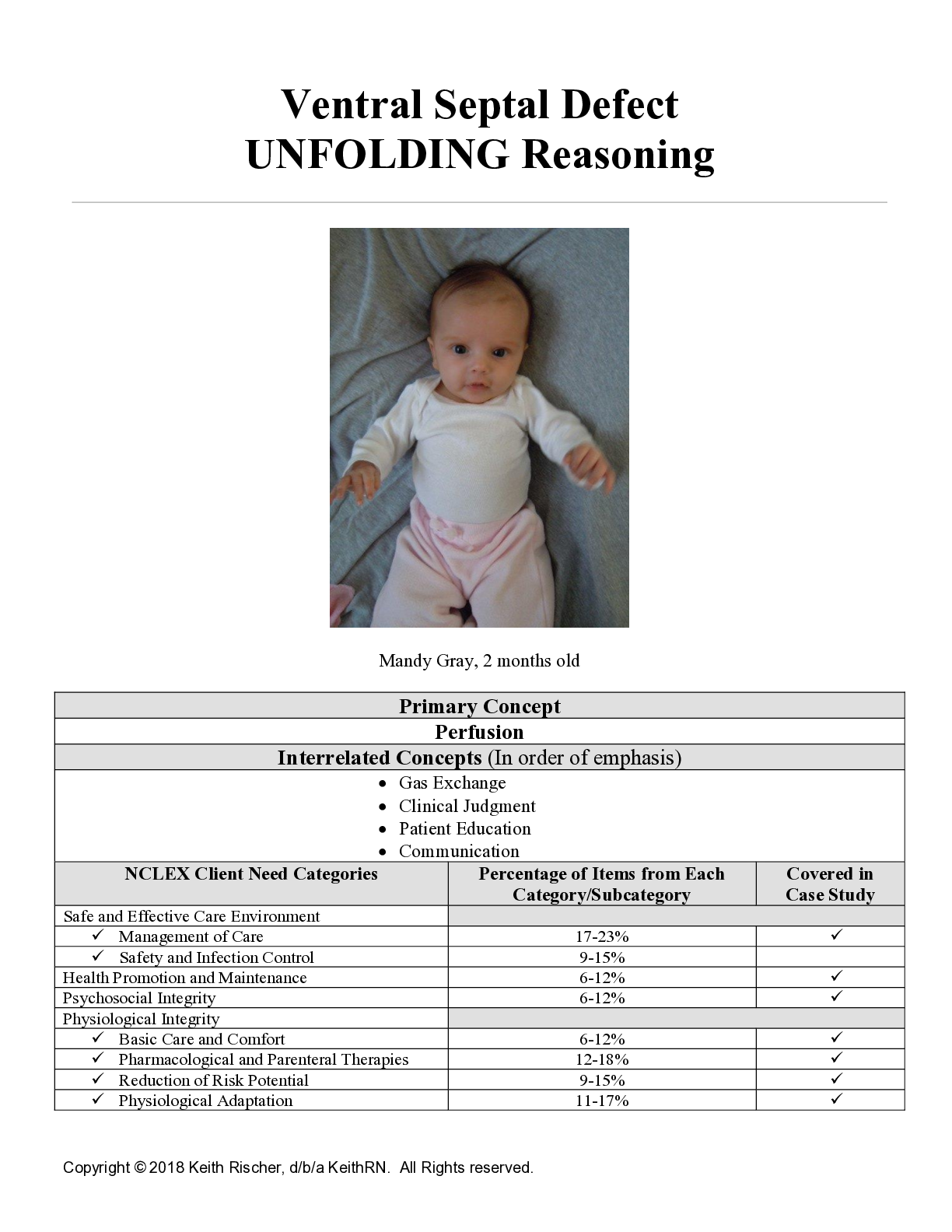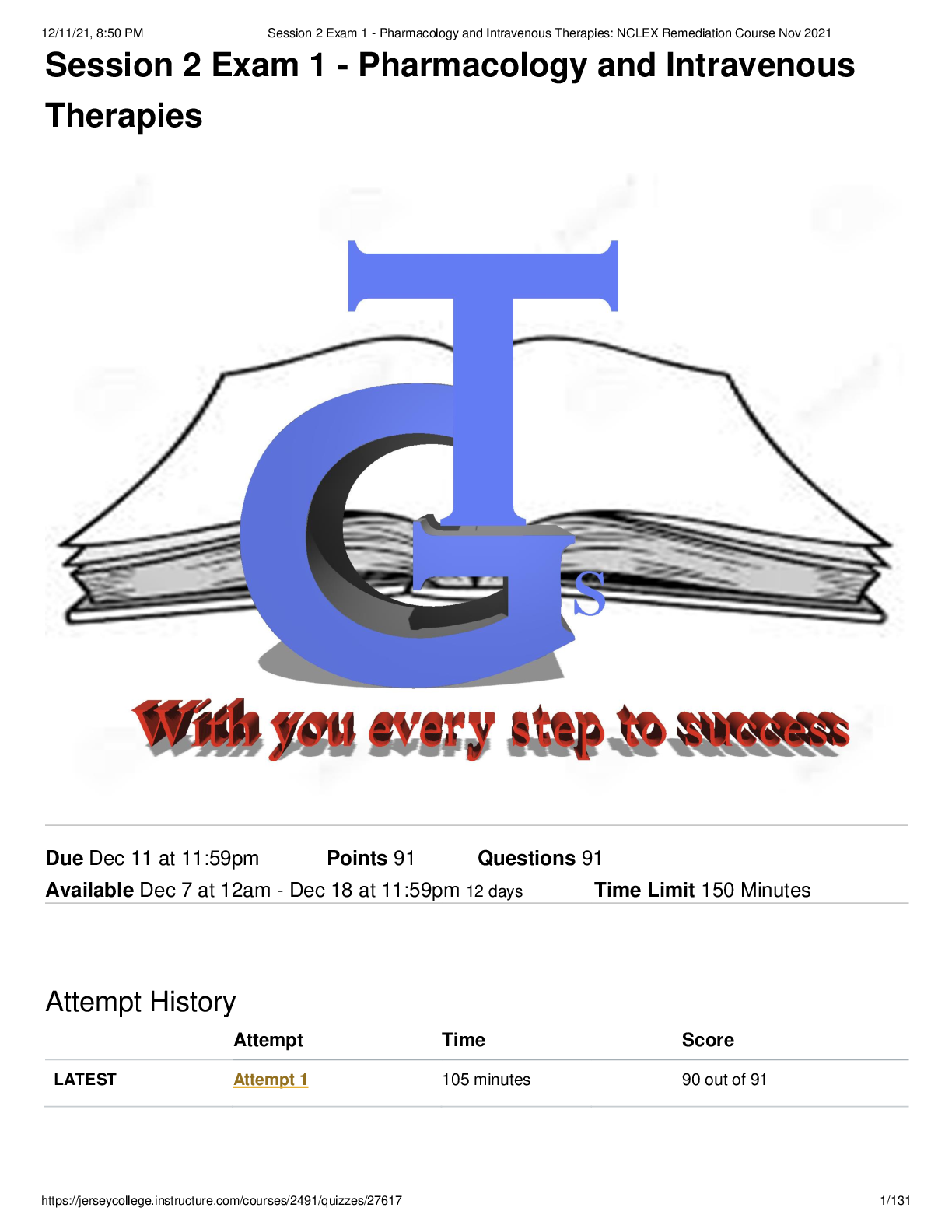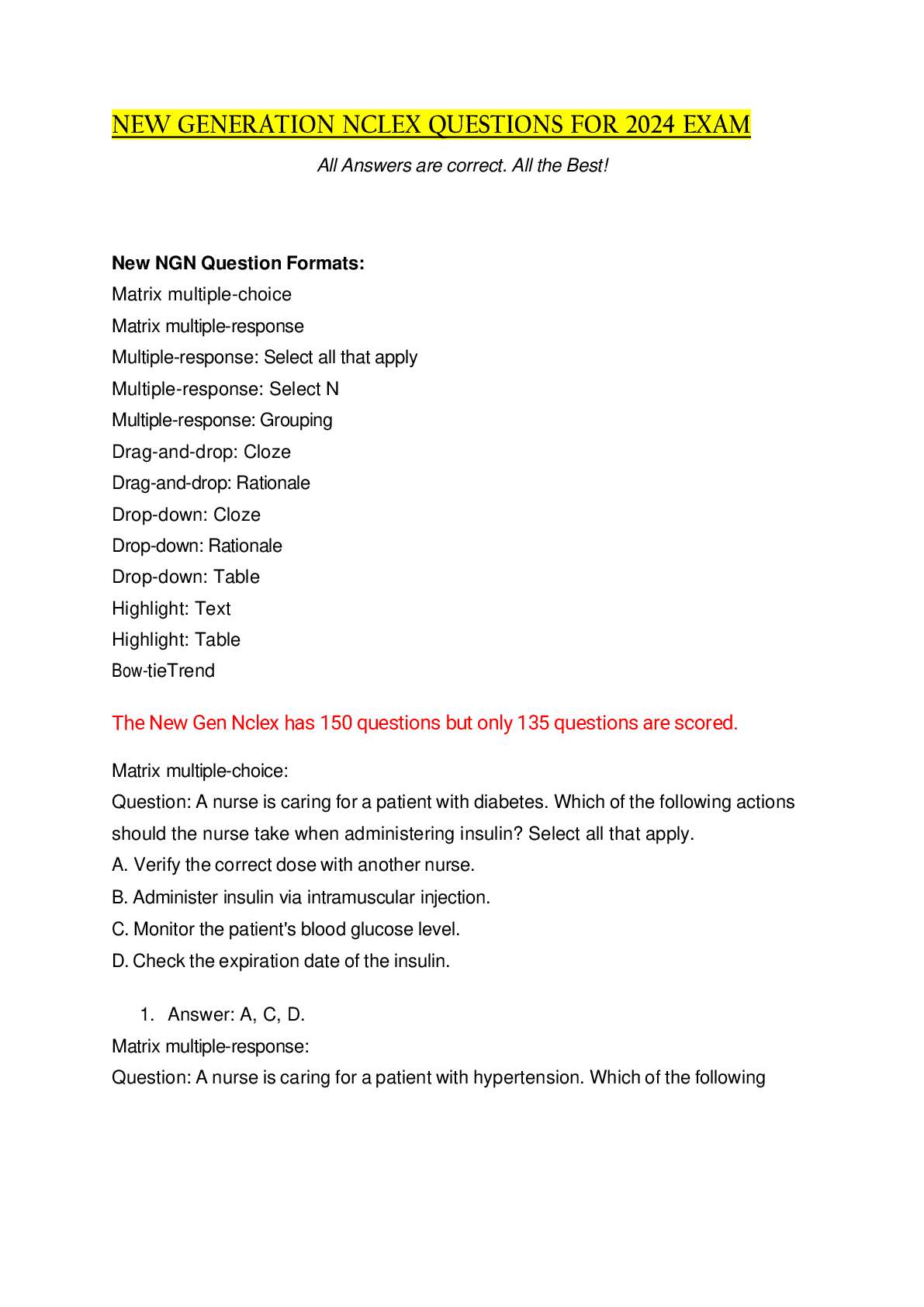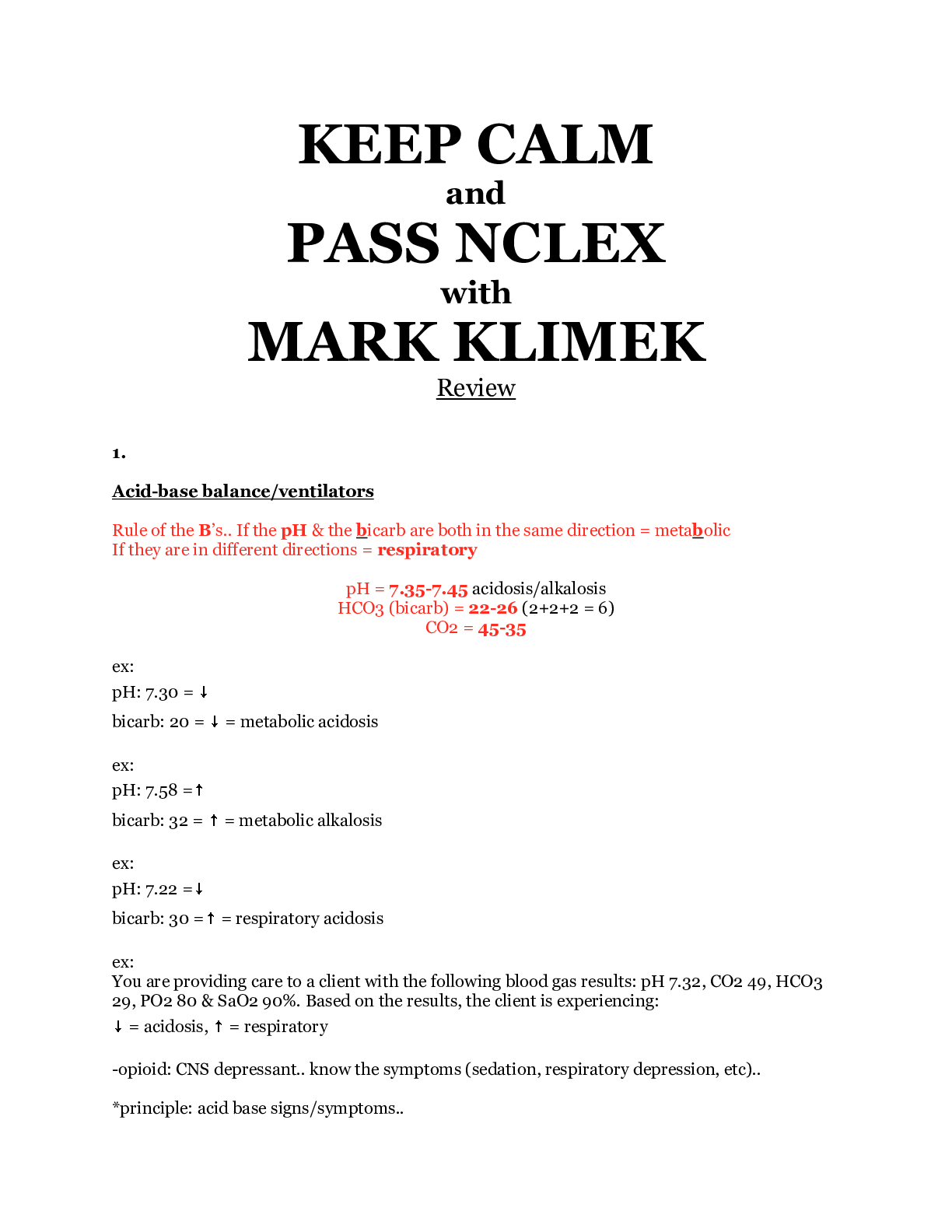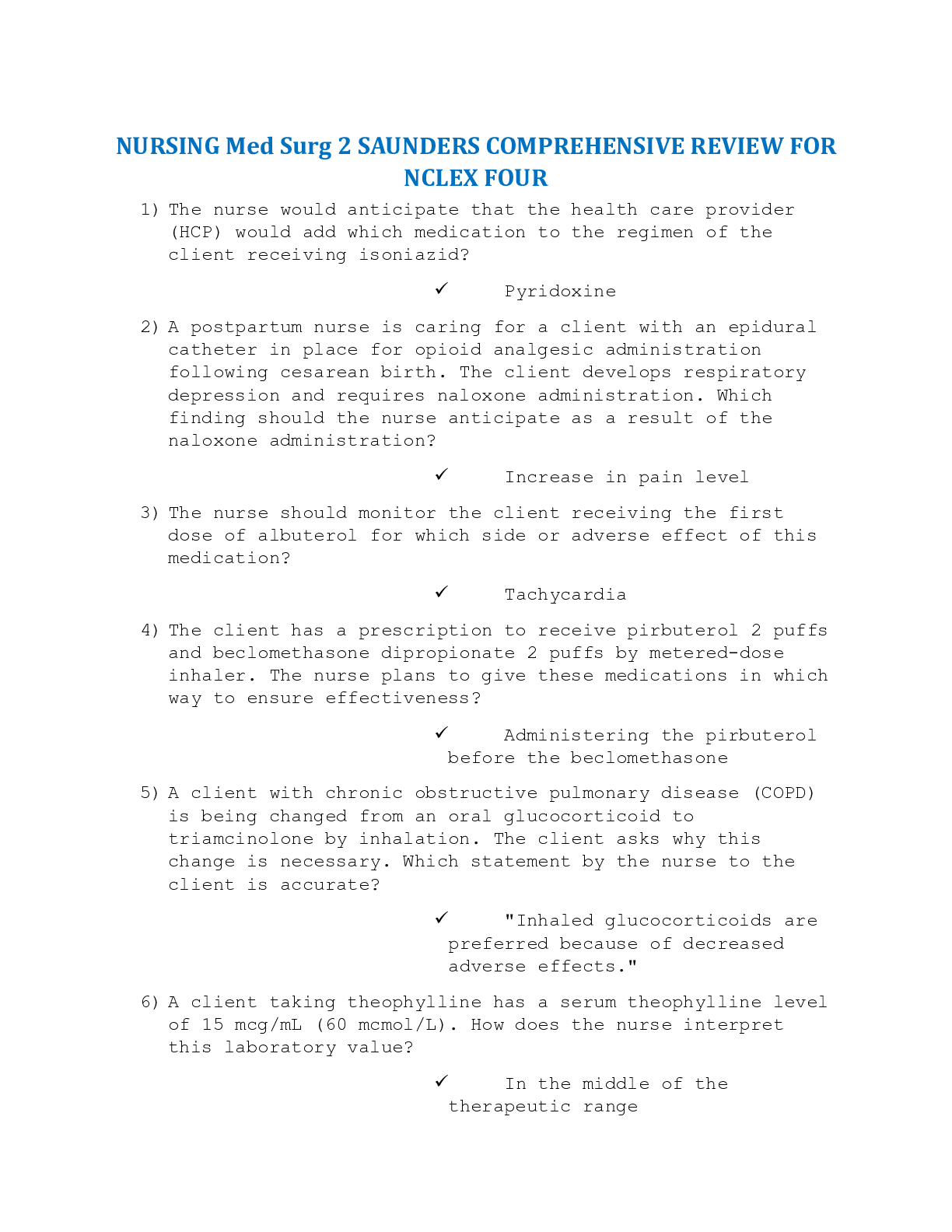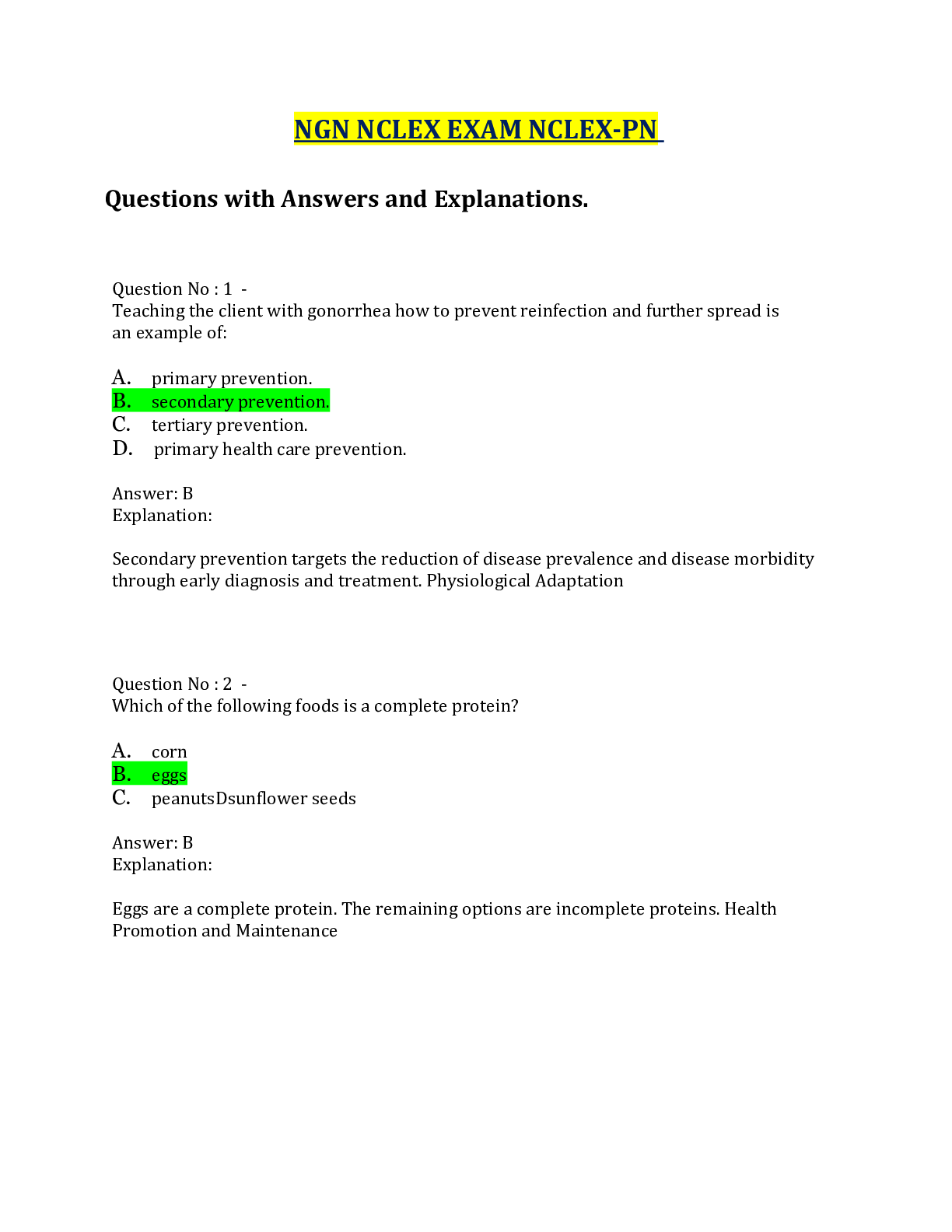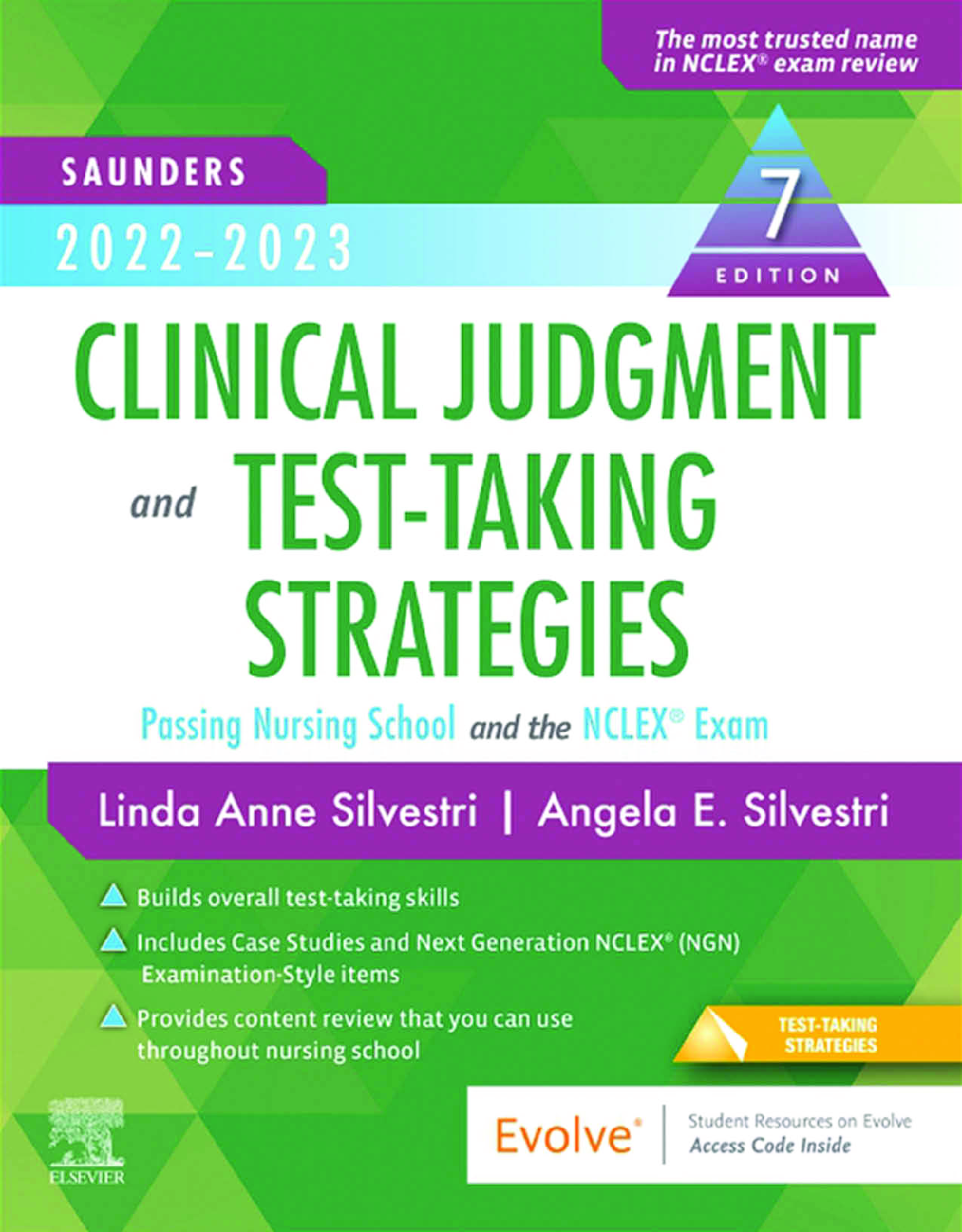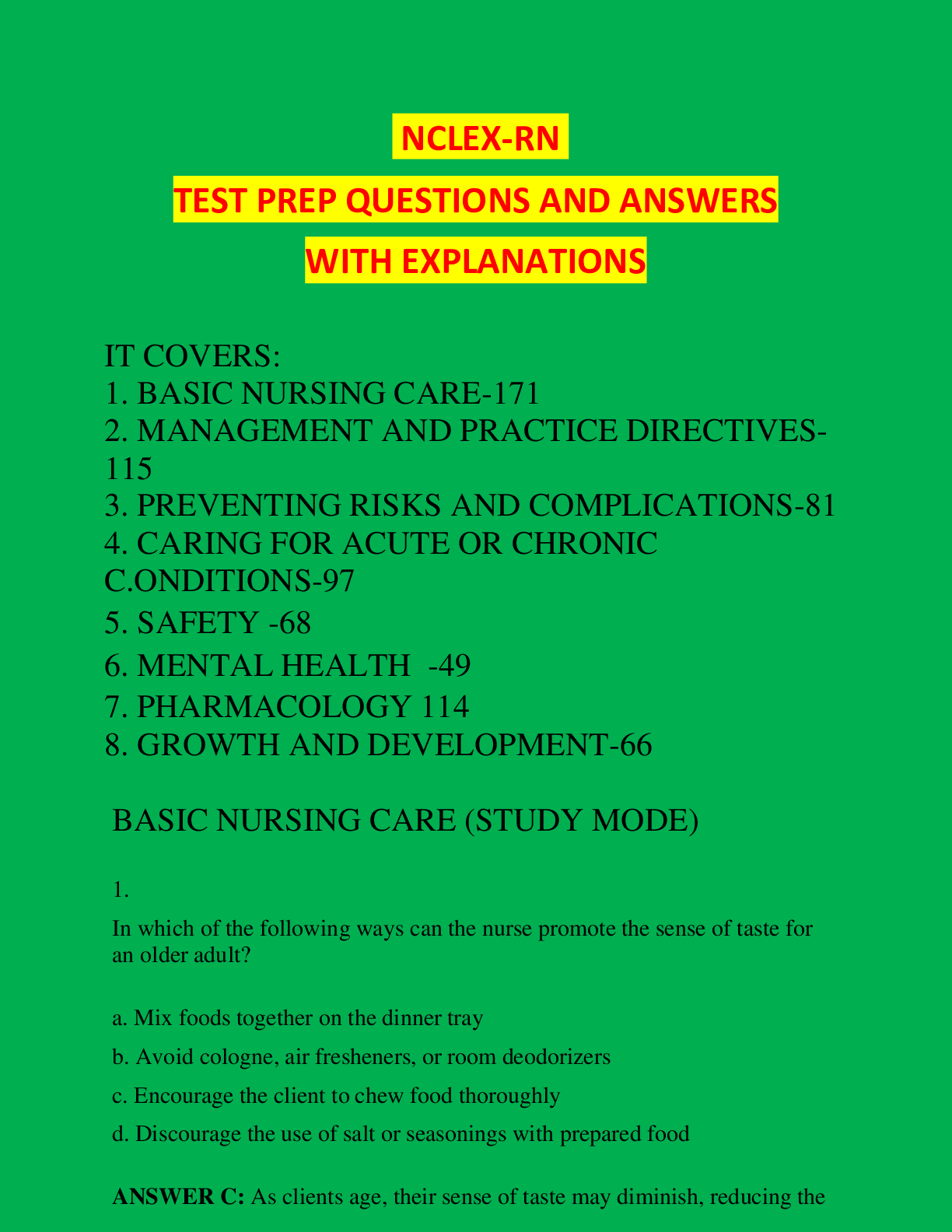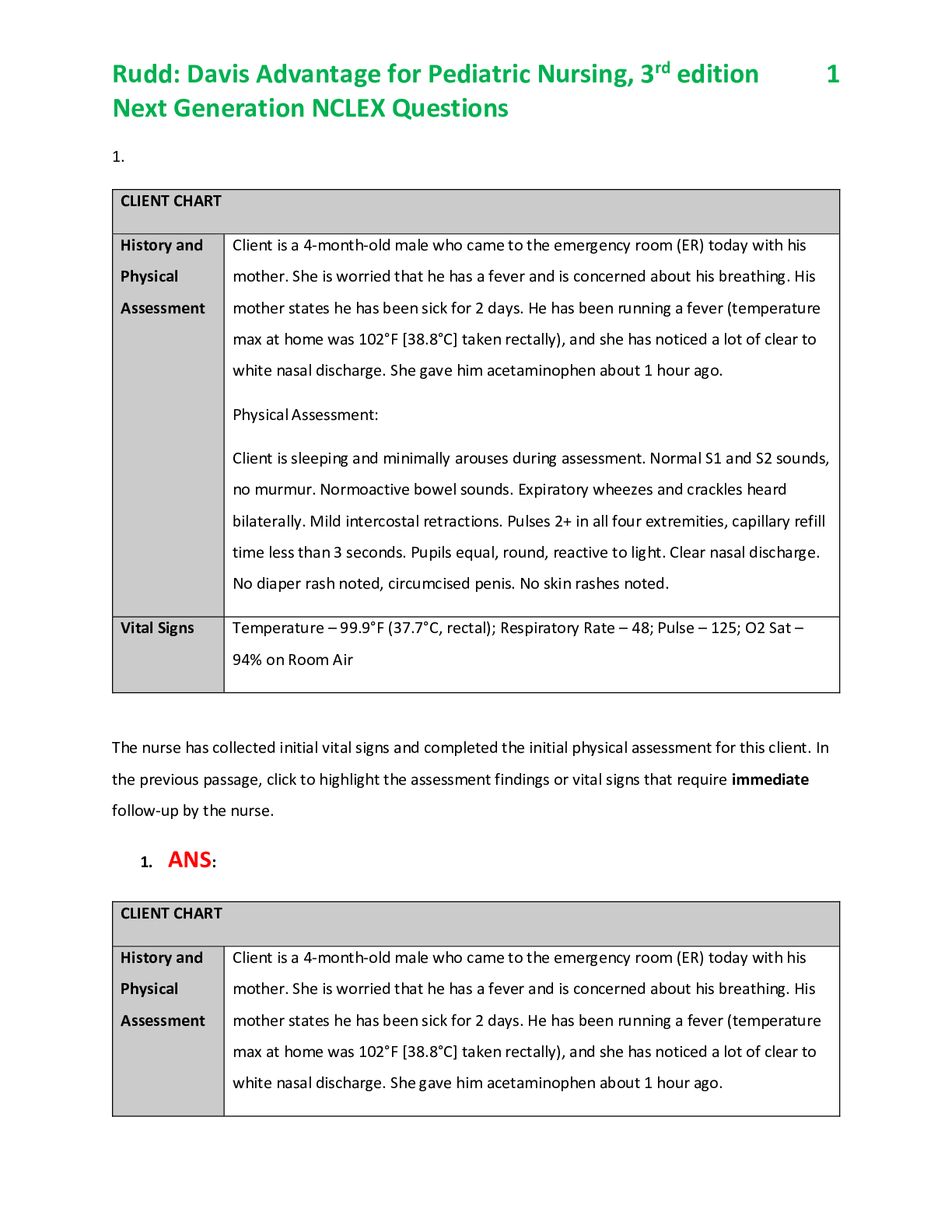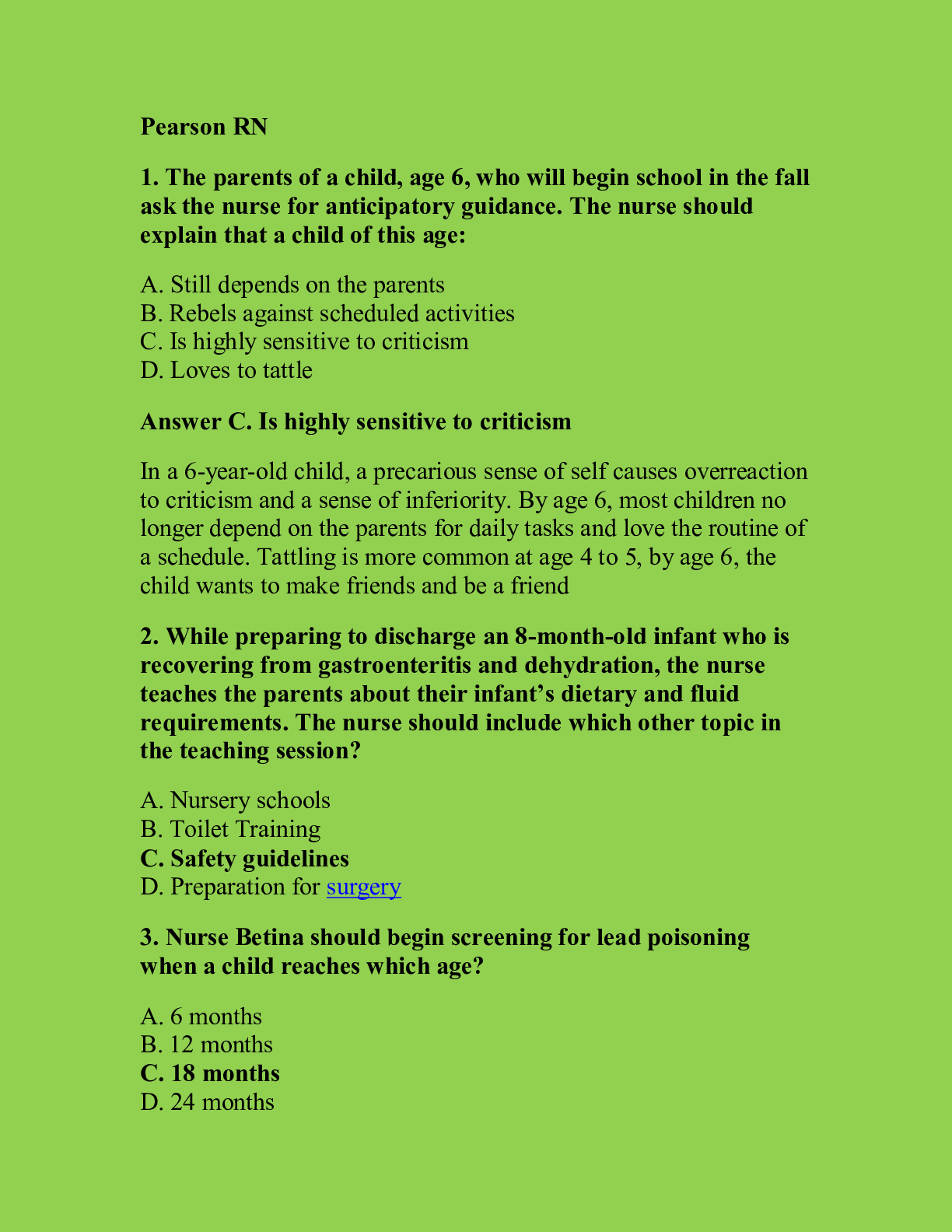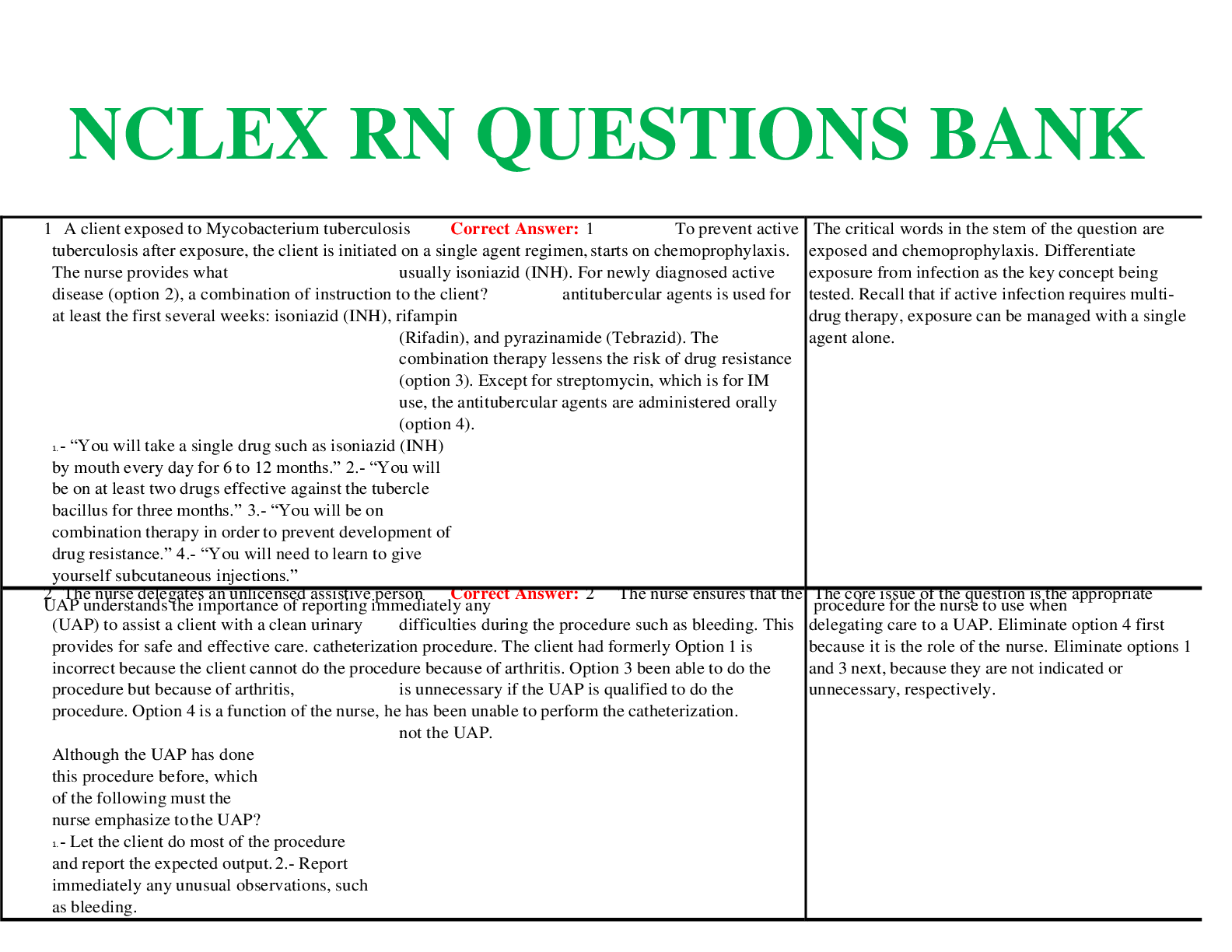*NURSING > NCLEX > NURSING NCLEX HSOR Module 8 Pharmacology and Intravenous Therapies | RATED A+ (All)
NURSING NCLEX HSOR Module 8 Pharmacology and Intravenous Therapies | RATED A+
Document Content and Description Below
Module 8 Questions 1. 1.ID: 383694396 A physician’s prescription reads, “Phenytoin (Dilantin) 0.1 g by mouth twice daily.” The medication label indicates that the bottle contains 100-mg cap... sules. How many capsules does the nurse prepare for administration of one dose? Correct Correct Responses: "1" <i>Rationale:</i> Convert 0.1 g to milligrams: 1000 mg = 1 g; therefore 0.1 g = 100 mg. Next use the medication formula:<i></i><i></i><i></i><i></i><i></i><i></i><i></i><br><i></i>< br><IMG src="/objects/NCLEX/silvestri1e_v1/mod_08/images/exam/M08Q044E01.gif" border=0><!-- RspH:I --><i></i><i></i><i></i><i></i><i></i><i></i><i></i><br><i></i><br>< IMG src="/objects/NCLEX/silvestri1e_v1/mod_08/images/exam/M08Q044E02.gif" border=0><!-- RspH:I --><i></i><i></i><i></i><i></i><i></i><i></i><i></i><br><i></i><i></i ><i></i><i></i><i></i><i></i><i></i><i></i><br><i></i><i>Test-Taking Strategy:</i> First, convert 0.1 g to mg. Next. follow the formula for the calculation of the correct dose. Recheck your work and ensure that the answer makes sense. If you had difficulty with this question, review medication calculation problems.<i></i><i></i><i></i><i></i><i></i><i></i><br><i></i><i></i> <i></i><i></i><i></i><i></i><i></i><i></i><br><i></i><i></i><i>Level of Cognitive Ability:</i> Applying<i></i><i></i><i></i><i></i><i></i><br><i></i><i></i><i></i>< i></i><i></i><i></i><i></i><i></i><br><i></i><i></i><i></i><i>Client Needs:</i> Physiological Integrity<i></i><i></i><i></i><i></i><br><i></i><i></i><i></i><i></i>< i></i><i></i><i></i><i></i><br><i></i><i></i><i></i><i></i><i>Integrat ed Process:</i> Nursing Process/Implementation<i></i><i></i><i></i><br><i></i><i></i><i></i><i ></i><i></i><i></i><i></i><i></i><br><i></i><i></i><i></i><i></i><i> </i><i>Content Area:</i> Medication Calculations<i></i><i></i><br><i></i><i></i><i></i><i></i><i></i><i></i ><i></i><i></i><br><i></i><i></i><i></i><i></i><i></i><i></i><i>Refe rence:</i> Potter, P., & Perry, A. (2009). <i>Fundamentals of nursing</i> (7th ed., pp. 695-699). St. Louis: Mosby. Awarded 1.0 out of 1.0 possible points. 2. 2.ID: 383694320 A client has a prescription for short-term therapy with enoxaparin (Lovenox). The nurse explains to the client that this medication is being prescribed to: A. Prevent pain B. Relieve back spasms C. Increase the client’s energy level D. Reduce the risk of deep vein thrombosis Correct Awarded 1.0 points out of 1.0 possible points. 3. 3.ID: 383695637 A client receiving parenteral nutrition (PN) requires fat emulsion (lipids), which will be piggybacked to the PN solution. On obtaining a bottle of fat emulsion, the nurse notes that fat globules are floating at the top of the solution. Which of these actions should the nurse take? A. Shaking the bottle vigorously B. Requesting a new bottle from the pharmacy Correct C. Rotating the bottle gently back and forth to mix the globules D. Running the bottle under warm water until the globules disappear Awarded 1.0 points out of 1.0 possible points. 4. 4.ID: 383695130 Risperidone (Risperdal) is prescribed for a client with a diagnosis of schizophrenia. Which laboratory study does the nurse expect to see among the physician’s prescriptions? A. Platelet count Correct B. Creatinine level C. Sedimentation rate D. Red blood cell count Awarded 1.0 points out of 1.0 possible points. 5. 5.ID: 383695122 The serum theophylline level of a client who is taking the medication (Theo-24) is 16 mcg/mL. On the basis of this result, the nurse will initially: A. Document the normal value on the chart Correct B. Call the healthcare provider immediately C. Call the rapid response team to help with the emergency D. Call the pharmacy to alert the pharmacist regarding the client’s theophylline level Awarded 1.0 points out of 1.0 possible points. 6. 6.ID: 383695614 A nurse has obtained a unit of blood from the blood bank and properly checked the blood bag with another nurse. Which of the following parameters does the nurse assess just before hanging the transfusion? A. Skin color B. Vital signs Correct C. Latest platelet count D. Urine output over the last 24 hours Awarded 1.0 points out of 1.0 possible points. 7. 7.ID: 383694391 At 1300, the nurse is documenting the receipt of a unit of packed blood cells at the hospital blood bank. The nurse calculates that the transfusion must be started by: A. 1315 B. 1330 Correct C. 1345 D. 1400 Awarded 1.0 points out of 1.0 possible points. 8. 8.ID: 383697107 A nurse hangs a 500-mL bag of intravenous (IV) fluid for an assigned client. One hour later the client complains of chest tightness, is dyspneic and apprehensive, and has an irregular pulse. The IV bag has 100 mL remaining. Which of the following actions should the nurse take first? A. Removing the IV B. Sitting the client up in bed C. Shutting off the IV infusion Correct D. Slowing the rate of infusion Rationale: The client’s symptoms are indicative of speed shock, which results from the rapid infusion of drugs or a bolus infusion. In this case, the nurse would note that 400 mL has infused over 60 minutes. The first action on the part of the nurse is shutting off the IV infusion. Other actions may follow in rapid sequence: The nurse may elevate the head of the bed to aid the client’s breathing and then immediately notify the healthcare provider. Slowing the infusion rate is inappropriate because the client will continue to receive fluid. The IV does not need to be removed. It may be needed to manage the complication. Test-Taking Strategy: Use the process of elimination, focusing on the data in the question. Note the question contains the strategic word “first.” Recognizing the signs of speed shock and recalling the appropriate interventions should also direct you to the option of shutting off the IV infusion. Review the initial nursing actions for speed shock if you had difficulty with this question. Level of Cognitive Ability: Applying Client Needs: Physiological Integrity Integrated Process: Nursing Process/Implementation Content Area: Intravenous Therapy Reference: Ignatavicius, D., & Workman, M. (2010). Medical-surgical nursing: Patient-centered collaborative care (6th ed., p. 230). St. Louis: Saunders. Awarded 1.0 points out of 1.0 possible points. 9. 9.ID: 383694370 A client taking hydrochlorothiazide reports to the clinic for follow-up blood tests. For which side effect of the medication does the nurse monitor the client’s laboratory results? A. Hypokalemia Correct B. Hypocalcemia C. Hypernatremia D. Hypermagnesemia Awarded 1.0 points out of 1.0 possible points. 10. 10.ID: 383697122 A nurse is caring for a client with a diagnosis of chronic renal failure who is receiving dialysis. Epoetin alfa (Epogen), to be administered subcutaneously, has been prescribed, and the nurse is drawing the medication from a single-use vial. The nurse should prepare the medication by: A. Shaking the vial before drawing up the medication B. Drawing up the medication and discarding the unused portion Correct C. Obtaining the medication from the medication freezer and allowing it to thaw D. Mixing the medication with 0.1 mL of heparin before administration to prevent clotting Awarded 1.0 points out of 1.0 possible points. 11. 11.ID: 383694332 A nurse answers a call bell and finds that the parenteral nutrition (PN) solution bag of an assigned client is empty. The new prescription was written for a new bag at the beginning of the shift, but it has not yet arrived from the pharmacy. Which of the following actions should the nurse take first? A. Calling the healthcare provider B. Calling the pharmacy for further instructions C. Hanging a solution of 10% dextrose in water Correct D. Hanging a solution of 5% dextrose in 0.9% sodium chloride Awarded 1.0 points out of 1.0 possible points. 12. 12.ID: 383697163 Disulfiram (Antabuse) is prescribed for a client. Which questions does the nurse make a priority of asking the client before administering this medication? Select all that apply. A. “When did you have your last full meal?” B. “Do you have a history of diabetes insipidus?” C. “When was your last drink of alcohol?” Correct D. “Do you have a history of thyroid problems?” Correct E. “Do you have a history of cancer in your family?” Rationale: Disulfiram (Antabuse) is used as an adjunct treatment for selected clients with alcoholism who want to remain in a state of enforced sobriety. Clients must abstain from alcohol intake for at least 12 hours before the initial dose of the medication is administered. The most important question is when the client had his last drink of alcohol. The medication is used with caution in clients with diabetes mellitus, hypothyroidism, epilepsy, cerebral damage, nephritis, and hepatic disease. It is also contraindicated in cases of severe heart disease, psychosis, or hypersensitivity to the medication. Test-Taking Strategy: Use the process of elimination. Recalling that the medication is used as an adjunct treatment for selected clients with alcoholism will help direct you to the option in which the client is asked when he consumed his last alcoholic drink. To find the other correct options, it is necessary to know the contraindications to the use of disulfiram. If you are unfamiliar with this medication and its use, review this content. Level of Cognitive Ability: Analyzing Client Needs: Physiological Integrity Integrated Process: Nursing Process/Assessment Awarded 1.0 points out of 1.0 possible points. 13. 13.ID: 383695126 A client is receiving heparin sodium by way of continuous IV infusion. For which adverse effects of the therapy does the nurse assess the client? Select all that apply. A. Tinnitus B. Tarry stools Correct C. Slowed pulse D. Bleeding from the gums Correct E. Increased blood pressure Awarded 1.0 points out of 1.0 possible points. 14. 14.ID: 383694389 Cyclophosphamide has been prescribed for a client with a diagnosis of breast cancer, and the nurse is providing instructions to the client. The nurse should tell the client: A. To avoid salt while taking this medication B. That it is best to take the medication with food C. To drink at least 2 glasses of orange juice every day D. To increase fluid intake to 2000 mL to 3000 mL/day Correct Rationale: Hemorrhagic cystitis is a toxic effect of cyclophosphamide. The client must be instructed to drink copious amounts of fluid during administration of this medication. The client should also monitor her urine for hematuria. The medication should be taken on an empty stomach, unless gastrointestinal upset occurs. Hyperkalemia may also result from the use of the medication; therefore the client would not be encouraged to increase potassium intake (i.e., bananas and orange juice). The client also would not be instructed to alter her sodium intake. Test-Taking Strategy: Knowledge regarding the toxic effects of cyclophosphamide will assist you in answering this question correctly. Correlate cyclophosphamide with hemorrhagic cystitis to direct you to the correct option. If you had difficulty with this question, review the toxic effects associated with this medication. Level of Cognitive Ability: Applying Client Needs: Physiological Integrity Integrated Process: Teaching and Learning Content Area: Pharmacology Reference: Kee, J., Hayes, E., & McCuistion, L. (2009). Pharmacology: A nursing process approach (6th ed., p. 538, 539). St. Louis: Saunders. Awarded 1.0 points out of 1.0 possible points. 15. 15.ID: 383695115 A nurse has just hung a transfusion of packed red blood cells and stayed with the client for the appropriate amount of time. Before leaving the room, the nurse tells the client that it is most important to immediately report which specific sign if it occurs? Select all that apply. A. Rash Correct B. Chills Correct C. Fatigue D. Backache Correct E. Tiredness Awarded 1.0 points out of 1.0 possible points. 16. 16.ID: 383695639 A nurse is assessing a client who is being hospitalized with a diagnosis of pneumonia. The client’s husband tells the nurse that the client is taking donepezil hydrochloride (Aricept). The nurse should ask the husband about the client’s history of which disorder? A. Dementia Correct B. Seizure disorder C. Diabetes mellitus D. Posttraumatic stress disorder Awarded 1.0 points out of 1.0 possible points. 17. 17.ID: 383694312 Warfarin sodium (Coumadin) has been prescribed, and the nurse teaches the client about the medication. Which statement by the client indicates that further teaching is necessary? A. “I won’t play football anymore.” B. “I won’t take any over-the-counter medications except aspirin.” Correct C. “I’ll use an electric shaver until the doctor stops the Coumadin prescription.” D. “I’ll buy one of those medication alert tags that tells people I’m taking an anticoagulant.” Rationale: No over-the-counter medications of any kind should be ingested by a client taking an anticoagulant. This is especially true of aspirin and aspirin- containing products (because of the potential for bleeding). The other options are correct statements. Strenuous games (e.g., contact sports) that may result in bruising and skin breakdown should be avoided. Electric shavers are less irritating to the skin than razors and less likely to cause skin breakdown. Medication alert tags are recommended in case of emergency. The client should also be taught to carry an identification card listing all medications currently being taken. Test-Taking Strategy: Use the process of elimination, noting the strategic words “further teaching is necessary,” which indicate a negative event query and the need to select the incorrect client statement. Recalling that warfarin sodium (Coumadin) is an anticoagulant and that anticoagulants can cause bleeding will direct you to the correct option. If you had difficulty with this question, review the teaching points for clients on anticoagulants. Level of Cognitive Ability: Evaluating Client Needs: Physiological Integrity Integrated Process: Teaching and Learning Content Area: Pharmacology Reference: Lehne, R. (2010). Pharmacology for nursing care (7th ed., p. 618). St. Louis: Saunders. Awarded 1.0 points out of 1.0 possible points. 18. 18.ID: 383695165 Carbamazepine (Tegretol) is prescribed for a client with trigeminal neuralgia. Which of the following side effects does the nurse instruct the client to report to the physician? Select all that apply. A. Fever Correct B. Nausea C. Headache D. Sore throat Correct E. Mouth sores Correct Awarded 1.0 points out of 1.0 possible points. 19. 19.ID: 383695141 A nurse is providing instruction to a client who is taking codeine sulfate for severe back pain. The nurse should tell the client to: A. Decrease fluid intake B. Maintain a high-fiber diet Correct C. Avoid all exercise to help prevent lightheadedness D. Avoid the use of stool softeners to help prevent diarrhea Awarded 1.0 points out of 1.0 possible points. 20. 20.ID: 383696340 A physician prescribes 1000 mL of 5% dextrose in water to be infused over 8 hours. The drop factor is 15 gtt/mL. At how many drops per minute does the nurse set the flow rate? (Round your answer to the nearest whole number). Incorrect Correct Responses: "31" <i>Rationale:</i> Use the IV flow rate formula:<i></i><i></i><i></i><i></i><i></i><i></i><i></i><br><i></i>< br><IMG src="/objects/NCLEX/silvestri1e_v1/mod_08/images/exam/M08Q039E01.gif" border=0><!-- RspH:I --><i></i><i></i><i></i><i></i><i></i><i></i><i></i><br><i></i><br>< IMG src="/objects/NCLEX/silvestri1e_v1/mod_08/images/exam/M08Q039E02.gif" border=0><!-- RspH:I --><i></i><i></i><i></i><i></i><i></i><i></i><i></i><br><i></i><i></i ><i></i><i></i><i></i><i></i><i></i><i></i><br><i></i><i>Test-Taking Strategy:</i> Use the formula for calculating IV flow rates to answer the question. Be careful with the multiplication and division, and remember to convert 8 hours to minutes (8 × 60 = 480) and round your answer to the nearest whole number. Review IV infusion rates if you had difficulty with this question.<i></i><i></i><i></i><i></i><i></i><i></i><br><i></i><i></i> <i></i><i></i><i></i><i></i><i></i><i></i><br><i></i><i></i><i>Level of Cognitive Ability:</i> Applying<i></i><i></i><i></i><i></i><i></i><br><i></i><i></i><i></i>< i></i><i></i><i></i><i></i><i></i><br><i></i><i></i><i></i><i>Client Needs:</i> Physiological Integrity<i></i><i></i><i></i><i></i><br><i></i><i></i><i></i><i></i>< i></i><i></i><i></i><i></i><br><i></i><i></i><i></i><i></i><i>Integrat ed Process:</i> Nursing Awarded 0.0 out of 1.0 possible points. 21. 21.ID: 383694316 The nurse is preparing to change the solution bag and intravenous tubing of a client receiving parenteral nutrition (PN) through a left subclavian central venous line. Which essential action does the nurse ask the client to perform just before switching the tubing? A. Turn the head to the left B. Turn the head to the right C. Exhale slowly and evenly D. Take a deep breath and hold it Correct Awarded 1.0 points out of 1.0 possible points. 22. 22.ID: 383695622 A nurse is preparing a plan of care for a pregnant client who will be given oxytocin (Pitocin) to induce labor. Which of the following occurrences does the nurse include in the plan of care as a reason for immediate discontinuation of the oxytocin infusion? A. Uterine atony B. Severe drowsiness C. Uterine hyperstimulation Correct D. Early decelerations of the fetal heart rate Rationale: Oxytocin, a synthetic hormone that stimulates uterine contractions, is a commonly used pharmacological means of inducing labor. One major concern associated with oxytocin is hyperstimulation of uterine contractions. Hyperstimulation of the uterus, which may result in diminished placental perfusion, may cause fetal distress. Therefore an oxytocin infusion must be stopped if there are any signs of uterine hyperstimulation. Early decelerations of the fetal heart rate are a reassuring sign and do not indicate fetal distress. Uterine atony and severe drowsiness are not indications of the need to discontinue the infusion. Test-Taking Strategy: Use the process of elimination. Knowing that induction of labor involves the stimulation of uterine contractions will help you answer this question. Using your knowledge of the effect of uterine contractions on uteroplacental circulation should help you recognize that hyperstimulation of contractions would compromise fetal oxygenation, a primary physiological need. Review the nursing implications associated with the administration of this medication if you had difficulty with this question. Level of Cognitive Ability: Analyzing Client Needs: Physiological Integrity Integrated Process: Nursing Process/Planning Content Area: Pharmacology Reference: Kee, J., Hayes, E., & McCuistion, L. (2009). Pharmacology: A nursing process approach (6th ed., p. 849). St. Louis: Saunders. Awarded 1.0 points out of 1.0 possible points. 23. 23.ID: 383697132 A client is receiving parenteral nutrition (PN) with fat emulsion (lipids) piggybacked to the PN solution. For which signs of an adverse reaction to the fat emulsion should the nurse monitor the client? Select all that apply. A. Chills Correct B. Pallor C. Headache Correct D. Chest and back pain Correct E. Nausea and vomiting Correct F. Subnormal temperature Awarded 1.0 points out of 1.0 possible points. 24. 24.ID: 383697155 A nurse is providing instructions to a client regarding quinapril hydrochloride (Accupril). The nurse teaches the client: A. To take the medication with meals B. To rise slowly from a lying to a sitting position Correct C. To discontinue the medication if nausea occurs D. That a therapeutic effect will be felt immediately Awarded 1.0 points out of 1.0 possible points. 25. 25.ID: 383697151 A nurse is caring for a client with histoplasmosis who is receiving intravenous amphotericin B (Fungizone). What should the nurse do while the medication is being administered? A. Monitor the client’s urine output Correct B. Monitor the client for hypothermia C. Check the client’s neurological status D. Check the client’s blood glucose level Rationale: Amphotericin B can produce medication toxicity during administration and exhibit symptoms such as chills, fever, headache, vomiting, and impairment of renal function. The medication is also irritating to the IV site, commonly causing thrombophlebitis. The nurse administering this medication watches for all of these problems. The other options are not specifically related to the administration of this medication. Test-Taking Strategy: Use the process of elimination and your knowledge of this potent medication to answer this question. Recalling that fever and chills may occur will help you eliminate monitoring of the client for hypothermia. To select from the remaining options, recall that the medication can be toxic to the kidneys, which should direct you to the correct option. Review nursing care in regard to the administration of this medication if you had difficulty with this question. Level of Cognitive Ability: Applying Client Needs: Physiological Integrity Integrated Process: Nursing Process/Implementation Content Area: Pharmacology Awarded 1.0 points out of 1.0 possible points. 26. 26.ID: 383696310 A physician prescribes the administration of parenteral nutrition (PN), to be started at a rate of 50 mL/hr by way of infusion pump through an established subclavian central line. After the first 2 hours of the PN infusion, the client suddenly complains of difficulty breathing and chest pain. The nurse immediately: A. Obtains blood for culture B. Clamps the PN infusion line Correct C. Obtains a sample for blood glucose testing D. Obtains an electrocardiogram (ECG) Rationale: One complication of a subclavian central line is embolism, caused by air or thrombus. Sudden onset of chest pain shortly after the initiation of PN may mean that this complication has developed. The infusion is clamped (the line should not be discontinued, however), the client turned on the left side with the head down, and the physician notified immediately. Depending on agency protocol, the rapid response team would also be called. Blood cultures are not necessary in this situation, because infection is not the concern. Likewise, there is no useful reason for checking the blood glucose level. An ECG may be obtained, but this is not the immediate priority. If the client shows signs of an air embolism, the nurse should examine the catheter to determine whether an open port has allowed air into the circulatory system. Test-Taking Strategy: Note the words “after the first 2 hours” and “immediately.” Focus on the data provided in the question to determine that an embolus has occurred. Eliminate blood cultures and blood glucose testing, which, respectively, relate to infection and hyperglycemia, which is not likely to occur during the first 2 hours of PN administration. To select from the remaining options, focus on the strategic word “immediately”; this will direct you to the correct option. Review the complications of PN and the associated nursing interventions if you had difficulty with this question. Level of Cognitive Ability: Applying Client Needs: Physiological Integrity Integrated Process: Nursing Process/Implementation Content Area: Parenteral Nutrition Reference: Perry, A., & Potter, P. (2010). Clinical nursing skills & techniques (7th ed., p. 850). St. Louis: Mosby. Awarded 1.0 points out of 1.0 possible points. 27. 27.ID: 383695124 A nurse is reviewing the laboratory results of a client receiving intravenous chemotherapy. Which of the following laboratory findings prompts the nurse to initiate neutropenic precautions? A. A clotting time of 10 minutes B. An ammonia level of 20 mcg/dL C. A platelet count of 100,000 cells/mm3 D. A white blood cell (WBC) count of 2000 cells/mm3 Correct Rationale: The normal WBC count is 4500 to 11,000 cells/mm3. When the WBC count drops, neutropenic precautions — including protective isolation to protect the client from infection — must be implemented. Bleeding precautions must be initiated when the platelet count drops. With bleeding precautions, traumatic procedures such as injections and rectal temperatures are avoided. The normal platelet count is 150,000 to 450,000 cells/mm3. The normal clotting time is 8 to 15 minutes. The normal ammonia value is 10 to 80 mcg/dL. Test-Taking Strategy: Use the process of elimination. Eliminate the options that identify normal laboratory values first. To select from the last two options, correlate a low WBC count with the need for neutropenic precautions and a low platelet count with the need for bleeding precautions. If you had difficulty with this question, review the interventions associated with caring for the client undergoing chemotherapy. Level of Cognitive Ability: Analyzing Client Needs: Physiological Integrity Integrated Process: Nursing Process/Implementation Content Area: Pharmacology Reference: Ignatavicius, D., & Workman, M. (2010). Medical-surgical nursing: Patient-centered collaborative care (6th ed., p. 426). St. Louis: Saunders. Awarded 1.0 points out of 1.0 possible points. 28. 28.ID: 383694376 A client who needs to receive a blood transfusion has experienced a pruritic rash during previous transfusions. The client asks the nurse whether it is safe to receive the transfusion. Which of the following medications does the nurse remember will likely be prescribed before the transfusion? A. Ibuprofen (Motrin) B. Acetaminophen (Tylenol) C. Diphenhydramine (Benadryl) Correct D. Acetylsalicylic acid (ASA, aspirin) Rationale: An urticarial reaction is characterized by a rash accompanied by pruritus. This type of transfusion reaction is prevented by pretreating the client with an antihistamine, such as diphenhydramine. Acetaminophen and acetylsalicylic acid are analgesics; ibuprofen is a nonsteroidal antiinflammatory medication. Test-Taking Strategy: To answer this question correctly, it is necessary to be familiar with this particular type of reaction and the medication that may be used in its prevention. Recalling that diphenhydramine is an antihistamine will direct you to the correct option. Review these medications if you had difficulty with this question. Level of Cognitive Ability: Analyzing Client Needs: Physiological Integrity Integrated Process: Nursing Process/Planning Content Area: Blood Administration Reference: Ignatavicius, D., & Workman, M. (2010). Medical-surgical nursing: Patient-centered collaborative care (6th ed., p. 920). St. Louis: Saunders. Awarded 1.0 points out of 1.0 possible points. 29. 29.ID: 383694364 A nurse is reading the medical record of a client receiving haloperidol (Haldol). The nurse notes that the physician has documented that the client is experiencing signs of akathisia. On the basis of the physician’s note, which clinical manifestation would the nurse expect to find during assessment of the client? A. Motor restlessness Correct B. Puffing of the cheeks C. Puckering of the mouth D. Protrusion of the tongue Awarded 1.0 points out of 1.0 possible points. 30. 30.ID: 383695132 A client rings the call bell and complains of pain at the site of an IV infusion. The nurse assesses the site and determines that phlebitis has developed. Which of the following actions should the nurse take? Select all that apply. A. Removing the IV catheter at that site Correct B. Applying warm, moist compresses to the IV site Correct C. Notifying the healthcare provider about the finding Correct D. Encouraging the client to scrub the site while in the shower E. Starting a new IV line in a proximal portion of the same vein Awarded 1.0 points out of 1.0 possible points. 31. 31.ID: 383695641 Packed red blood cells have been prescribed for a client with low hemoglobin and hematocrit values. The nurse takes the client’s temperature orally before hanging the blood transfusion and notes that it is 100.0° F. What should the nurse do next? A. Call the healthcare provider Correct B. Begin the transfusion as prescribed C. Administer an antihistamine and begin the transfusion D. Administer 2 tablets of acetaminophen (Tylenol) and begin the transfusion Rationale: If the client has a temperature of 100.0° F or higher, the unit of blood should not be hung until the physician has been notified and had the opportunity to give further prescriptions. It is likely that the healthcare provider will prescribe the blood to be administered despite the temperature, but it is not within the nurse’s scope of practice to make that determination. Therefore the other options are incorrect. Additionally, medications are not administered to the client without a prescription. Test-Taking Strategy: Use the process of elimination. First eliminate the options that are comparable or alike in that they call for administration of a medication. Choose calling the healthcare provider over beginning the transfusion as prescribed, knowing that an increased temperature is abnormal. Review the procedure for blood transfusions if you had difficulty with this question. Level of Cognitive Ability: Applying Client Needs: Physiological Integrity Integrated Process: Nursing Process/Implementation Content Area: Blood Administration References: Black, J., & Hawks, J. (2009). Medical-surgical nursing: Clinical management for positive outcomes (8th ed., p. 2015). St. Louis: Saunders. Perry, A., & Potter, P. (2010). Clinical nursing skills & techniques (7th ed., p. 791). St. Louis: Mosby. Awarded 1.0 points out of 1.0 possible points. 32. 32.ID: 383694310 A client who is taking bupropion (Wellbutrin) in an attempt to stop smoking tells a nurse that he has been doubling the daily dose to make it easier to resist smoking. The nurse warns the client that doubling the daily dosage is dangerous. Of which adverse effect of the medication does the nurse warn the client? A. Insomnia B. Seizures Correct C. Weight gain D. Orthostatic hypotension Awarded 1.0 points out of 1.0 possible points. 33. 33.ID: 383694358 A client with newly diagnosed angina pectoris has taken 2 sublingual nitroglycerin tablets for chest pain. The chest pain is relieved, but the client complains of a headache. The nurse tells the client that: A. This is an indication that the medication should not be used again B. Headache indicates medication tolerance, and the dosage must be increased C. This may be an allergic reaction to the nitroglycerin, and the physician must be notified D. This is an expected side effect of the nitroglycerin, and the client can relieve it by taking acetaminophen (Tylenol) Correct Awarded 1.0 points out of 1.0 possible points. 34. 34.ID: 383695645 A nurse suspects that a client receiving parenteral nutrition (PN) through a central line has an air embolism. The nurse immediately positions the client on the: A. Left side with the head lower than the feet Correct B. Left side with the head higher than the feet C. Right side with the head lower than the feet D. Right side with the head higher than the feet Awarded 1.0 points out of 1.0 possible points. 35. 35.ID: 383695624 A client with a thoracic spinal cord injury is receiving dantrolene sodium (Dantrium). Which statement by the client indicates to the nurse that the client is experiencing an undesired effect of the medication? A. “I’m feeling really drowsy.” Correct B. “My legs are very relaxed.” C. “I can’t seem to get enough to eat.” D. “I urinate about the same amount as I always did.” Awarded 1.0 points out of 1.0 possible points. 36. 36.ID: 383696396 Erythromycin is prescribed for a client with a respiratory tract infection. The nurse provides instructions to the client regarding the administration of the oral medication and tells the client to take the medication: A. With juice B. With a meal C. On an empty stomach Correct D. At bedtime, with a snack Awarded 1.0 points out of 1.0 possible points. 37. 37.ID: 383695111 A nurse is monitoring a client who is receiving parenteral nutrition (PN). Which of the following signs and symptoms causes the nurse to suspect that the client is experiencing hyperglycemia as a complication? A. Pallor, weak pulse, and anuria B. Nausea, vomiting, and oliguria C. Nausea, thirst, and increased urine output Correct D. Sweating, chills, and decreased urine output Awarded 1.0 points out of 1.0 possible points. 38. 38.ID: 383695612 A client with tuberculosis is being started on isoniazid (INH), and the nurse stresses the importance of returning to the clinic for follow-up blood testing. Which blood test will be performed? A. Liver enzymes Correct B. Serum creatinine C. Blood urea nitrogen D. Red blood cell count Rationale: INH therapy can increase hepatic enzymes and cause hepatitis. Therefore the client’s liver enzymes are assessed when therapy is initiated and during the first 3 months of therapy. Monitoring may be continued further in the client who is older than 50 or abuses alcohol. The other options are not specifically related to the use of this medication. Test-Taking Strategy: Use the process of elimination. Eliminate blood urea nitrogen and serum creatinine because they are comparable or alike in that they are indicators of renal function. To select from the remaining options, it is necessary to know that this medication can be toxic to the liver. Review the adverse effects of the various antituberculosis medications if you had difficulty with this question. Level of Cognitive Ability: Applying Client Needs: Physiological Integrity Integrated Process: Nursing Process/Implementation Content Area: Pharmacology Reference: Lehne, R. (2010). Pharmacology for nursing care (7th ed., pp. 1043, 1044, 1050). St. Louis: Saunders. Awarded 1.0 points out of 1.0 possible points. 39. 39.ID: 383694314 Zidovudine (AZT) is prescribed for an adult client with HIV infection. The nurse, while providing instructions to the client, should tell the client: A. That the medication must be taken with milk B. That aspirin can be taken to treat headache C. To discontinue the medication if nausea occurs D. To space the doses evenly around the clock Correct Rationale: The adult dosage of zidovudine is usually 200 mg every 8 hours or 300 mg every 12 hours. The client is instructed to space doses of the medication evenly around the clock. Food or milk does not affect the gastrointestinal absorption of the medication. The client is instructed to continue therapy for the full prescribed duration of treatment. The client is also instructed not to take any medication, including aspirin, without the physician’s approval. Test-Taking Strategy: Use the process of elimination. Knowledge of the basic principles of medication administration will assist you in eliminating the option referring to discontinuation of the medication. To select from the remaining options, recall that this medication is an antiviral, which will direct you to the correct option. Remember that evenly spaced doses are necessary to maintain virustatic concentrations of the medication. Review client teaching points for this medication if you had difficulty with this question. Level of Cognitive Ability: Applying Client Needs: Physiological Integrity Integrated Process: Teaching and Learning Content Area: Pharmacology Reference: Skidmore-Roth, L. (2009). Mosby’s drug guide for nurses (8th ed., p. 1014). St. Louis: Mosby. Awarded 1.0 points out of 1.0 possible points. 40. 40.ID: 383695185 A client has a prescription for a unit of packed red blood cells (RBCs). Which of the following IV solutions should the nurse obtain to hang with the blood product at the client’s bedside? A. 0.9% sodium chloride Correct B. Lactated Ringer’s solution (LR) C. 5% dextrose in 0.9% sodium chloride D. 5% dextrose in water in 0.45% sodium chloride Awarded 1.0 points out of 1.0 possible points. 41. 41.ID: 383697153 A pregnant client is receiving magnesium sulfate for the management of preeclampsia. Which of the following assessment findings indicates to the nurse that the client is experiencing magnesium toxicity? A. Proteinuria of +3 B. Sudden drop in fetal heart rate Correct C. Presence of deep tendon reflexes D. Serum magnesium level of 6 mEq/L Awarded 1.0 points out of 1.0 possible points. 42. 42.ID: 383694306 A nurse is preparing a plan of care for a client with renal colic who is receiving meperidine hydrochloride (Demerol) for pain. Which side effects does the nurse make a note of needing to be alert to in the plan of care? Select all that apply. A. Hypotension Correct B. Constipation Correct C. Bradycardia D. Urine retention Correct E. Respiratory depression Correct Awarded 1.0 points out of 1.0 possible points. 43. 43.ID: 383694338 A client is taking a folic acid supplement (Folate). Which of the following laboratory parameters does the nurse use to evaluate the effectiveness of this therapy? Select all that apply. A. Magnesium B. Hemoglobin Correct C. Blood glucose D. Hematocrit Correct E. Alkaline phosphatase Awarded 1.0 points out of 1.0 possible points. 44. 44.ID: 383694324 A nurse is caring for a group of adult clients on an acute care nursing unit. Which of the following clients does the nurse recognize as the least likely candidate for parenteral nutrition (PN)? A. 61-year-old client with pancreatitis B. 52-year-old client with severe sepsis C. 45-year-old client who has undergone repair of a hiatal hernia Correct D. 24-year-old client with a severe exacerbation of ulcerative colitis Awarded 1.0 points out of 1.0 possible points. 45. 45.ID: 383695668 A nurse has taught a client who is taking lithium carbonate (Lithobid) about the medication. The nurse determines that the client needs additional teaching if the client states that: A. The medication should be taken with meals B. The lithium blood levels must be monitored very closely C. It is important to decrease fluid intake while taking the medication to avoid nausea Correct D. The physician must be called if excessive diarrhea, vomiting, or diaphoresis occurs Awarded 1.0 points out of 1.0 possible points. 46. 46.ID: 383695618 At 1600 the nurse checks a client’s parenteral nutrition (PN) infusion bag and finds 1100 mL remaining in the 3000-mL bag. The solution is running at a rate of 100 mL/hr. The bag was hung the previous day at 1800. The nurse plans to change the infusion bag and tubing this evening at: A. 1700 B. 1800 Correct C. 2000 D. 2100 Rationale: The PN solution should be changed every 24 hours as a means of helping prevent infection. Infection is also prevented with the use of aseptic technique during bag and tubing changes. Most agencies recommend that tubing be changed every 24 hours along with the PN infusion bag. Specific agency policies should always be followed. The nurse should also use a filter when administering PN in accordance with hospital protocol. Therefore the remaining options are incorrect. Test-Taking Strategy: Use the process of elimination. Recalling that the infusion bag should be changed every 24 hours will direct you to the correct option. Review the principles of PN administration if you had difficulty with this question. Level of Cognitive Ability: Applying Client Needs: Physiological Integrity Integrated Process: Nursing Process/Planning Content Area: Parenteral Nutrition References: Ignatavicius, D., & Workman, M. (2010). Medical-surgical nursing: Patient-centered collaborative care (6th ed., p. 1401). St. Louis: Saunders. Awarded 1.0 points out of 1.0 possible points. 47. 47.ID: 383694328 A client has been taking metoprolol (Lopressor, Toprol-XL). Which of the following findings indicates to the clinic nurse that the medication is effective? A. The client’s ankles are swollen. B. The client’s weight has increased. C. The client’s blood pressure has decreased. Correct D. The client has wheezes in the lower lobes of the lungs. Awarded 1.0 points out of 1.0 possible points. 48. 48.ID: 383747904 A physician prescribes an intramuscular dose of 200,000 units of penicillin G benzathine (Bicillin) for an adult client. The label on the 10-mL ampule sent from the pharmacy reads, “Penicillin G benzathine (Bicillin), 300,000 units/mL.” How many milliliters of medication does the nurse prepares to ensure administration of the correct dose? (Round your answer to the nearest tenth.) Correct br><IMG src="/objects/NCLEX/silvestri1e_v1/mod_08/images/exam/M08Q040E01.gif" border=0><!-- RspH:I --><i></i><i></i><i></i><i></i><i></i><i></i><i></i><br><i></i><br>< IMG src="/objects/NCLEX/silvestri1e_v1/mod_08/images/exam/M08Q040E02.gif" border=0><!-- RspH:I --><i></i><i></i><i></i><i></i><i></i><i></i><i></i><br><i></i><i></i ><i></i><i></i><i></i><i></i><i></i><i></i><br><i></i><i>Test-Taking Strategy:</i> Follow the formula for the calculation of the correct dose. It is not necessary to perform a conversion in this problem. Recheck your work, ensure that the answer makes sense, and remember to round your answer to the nearest tenth. If you had difficulty with this question, review medication calculation problems.<i></i><i></i><i></i><i></i><i></i><i></i><br><i></i><i></i> <i></i><i></i><i></i><i></i><i></i><i></i><br><i></i><i></i><i>Level of Cognitive Ability:</i> Applying<i></i><i></i><i></i><i></i><i></i><br><i></i><i></i><i></i>< i></i><i></i><i></i><i></i><i></i><br><i></i><i></i><i></i><i>Client Needs:</i> Physiological Integrity<i></i><i></i><i></i><i></i><br><i></i><i></i><i></i><i></i>< i></i><i></i><i></i><i></i><br><i></i><i></i><i></i><i></i><i>Integrat ed Process:</i> Nursing Process/Implementation<i></i><i></i><i></i><br><i></i><i></i><i></i><i ></i><i></i><i></i><i></i><i></i><br><i></i><i></i><i></i><i></i><i> </i><i>Content Area:</i> Medication Calculations<i></i><i></i><br><i></i><i></i><i></i><i></i><i></i><i></i ><i></i><i></i><br><i></i><i></i><i></i><i></i><i></i><i></i><i>Refe rence:</i> Potter, P., & Perry, A. (2009). <i>Fundamentals of nursing</i> (7th ed., pp. 695-699). St. Louis: Mosby. Awarded 1.0 out of 1.0 possible points. 49. 49.ID: 383697140 A nurse is providing dietary instructions to a client taking spironolactone (Aldactone). Which of the following foods does the nurse instruct the client to avoid? Select all that apply. A. Rice B. Cereal C. Carrots D. Bananas Correct E. Citrus fruits Correct Awarded 1.0 points out of 1.0 possible points. 50. 50.ID: 383696362 A nurse has taught a client taking a methylxanthine bronchodilator about beverages that must be avoided. Which beverage choices by the client indicate to the nurse that the client needs further education? Select all that apply. A. Cocoa Correct B. Coffee Correct C. Lemonade D. Orange juice E. Chocolate milk Correct Awarded 1.0 points out of 1.0 possible points. 51. 51.ID: 383694372 A client with schizophrenia who has been taking an antipsychotic medication calls the clinic nurse and says, “I need to cancel my appointment with the psychiatrist again, because I still have this awful sore throat. It’s so bad that my mouth has a sore.” How does the nurse respond to the client? A. “I wouldn’t be upset. It happens when you aren’t drinking enough water.” B. “I think you need to come in for blood work today, because this may be a side effect of your medicine.” Correct C. “Do you remember when you started this medication? Your psychiatrist told you how important it is to keep your appointments with him.” D. “You probably have a simple flu, but it might help if you gargle with some antiseptic mouthwash every 2 hours or so and drink plenty of water.” Rationale: Agranulocytosis, an adverse effect of antipsychotic medications, is characterized by a sore throat with mouth sores, fever, and malaise. Any client taking such a medication who complains of flulike symptoms should be evaluated carefully. For this reason, the psychiatrist usually prescribes periodic blood tests while a client is taking antipsychotic medications. The incorrect options ignore the client’s complaints. Test-Taking Strategy: Use the process of elimination and focus on the data in the question. Recalling that antipsychotic medications can cause agranulocytosis will direct you to the correct option. Also note that the correct option is the only one that addresses the client’s complaint. Review the adverse effects of antipsychotic medications if you had difficulty with this question. Level of Cognitive Ability: Applying Client Needs: Physiological Integrity Integrated Process: Nursing Process/Implementation Content Area: Pharmacology Reference: Varcarolis, E., & Halter, M. (2009). Essentials of psychiatric mental health nursing: A communication approach to evidence-based care (p. 297). St. Louis: Saunders. Awarded 1.0 points out of 1.0 possible points. 52. 52.ID: 383696349 A physician’s prescription reads, “Clindamycin phosphate (Cleocin Phosphate) 0.3 g in 50 mL NS, to be administered IV over 30 minutes.” The medication label reads, “Clindamycin phosphate (Cleocin Phosphate) 150 mg/mL.” How many milliliters of medication does the nurse prepare to ensure that the correct dose is administered? Correct Correct Responses: "2" <i>Rationale:</i> Convert 0.3 g to milligrams: 1000 mg = 1 g and therefore 0.3 g = 300 mg. Next, use the medication formula:<i></i><i></i><i></i><i></i><i></i><i></i><i></i><br><i></i>< br><IMG src="/objects/NCLEX/silvestri1e_v1/mod_08/images/exam/M08Q043E01.gif" border=0><!-- RspH:I --><i></i><i></i><i></i><i></i><i></i><i></i><i></i><br><i></i><br>< IMG src="/objects/NCLEX/silvestri1e_v1/mod_08/images/exam/M08Q043E02.gif" border=0><!-- RspH:I --><i></i><i></i><i></i><i></i><i></i><i></i><i></i><br><i></i><i></i ><i></i><i></i><i></i><i></i><i></i><i></i><br><i></i><i>Test-Taking Strategy:</i> First convert 0.3 gm to mg. Next follow the formula for the calculation of the correct dose. Recheck your work and make sure that the answer makes sense. If you had difficulty with this question, review medication calculation problems.<i></i><i></i><i></i><i></i><i></i><i></i><br><i></i><i></i> <i></i><i></i><i></i><i></i><i></i><i></i><br><i></i><i></i><i>Level of Cognitive Ability:</i> Applying<i></i><i></i><i></i><i></i><i></i><br><i></i><i></i><i></i>< i></i><i></i><i></i><i></i><i></i><br><i></i><i></i><i></i><i>Client Needs:</i> Physiological Integrity<i></i><i></i><i></i><i></i><br><i></i><i></i><i></i><i></i>< i></i><i></i><i></i><i></i><br><i></i><i></i><i></i><i></i><i>Integrat ed Process:</i> Nursing Process/Implementation<i></i><i></i><i></i><br><i></i><i></i><i></i><i ></i><i></i><i></i><i></i><i></i><br><i></i><i></i><i></i><i></i><i> </i><i>Content Area:</i> Medication Calculations<i></i><i></i><br><i></i><i></i><i></i><i></i><i></i><i></i ><i></i><i></i><br><i></i><i></i><i></i><i></i><i></i><i></i><i>Refe rence:</i> Potter, P., & Perry, A. (2009). <i>Fundamentals of nursing</i> (7th ed., pp. 695-699). St. Louis: Mosby. Awarded 1.0 out of 1.0 possible points. 53. 53.ID: 383747596 The nurse determines that the client is exhibiting signs of a hemolytic transfusion reaction while receiving a blood transfusion. Place the actions the nurse should perform in the correct order, with number 1 the first action and number 5 the last action: Correct A. Stopping the infusion of blood B. Hanging an IV bag of normal saline solution (NS) at a keep-vein-open (KVO) rate C. Notifying the healthcare provider D. Obtaining vital signs/oxygen saturation E. Documenting the findings Rationale: If a transfusion reaction is suspected, the transfusion is immediately stopped and NS infused, pending further physician prescriptions. Next, the healthcare provider should be notified. Ensuring patent IV access also helps maintain the client’s intravascular volume. NS is the solution of choice, rather than solutions containing dextrose, because red blood cells do not clump with NS. Vital signs and oxygen saturation are monitored closely. Finally, the nurse documents the findings and the client’s response to the interventions. Test-Taking Strategy: Note that the client is experiencing a having a hemolytic transfusion reaction. The question sets forth the problem; the nurse must determine the order in which interventions should be performed. First, the blood transfusion is stopped and an isotonic solution infused. Next the nurse should notify the healthcare provider, check vital signs and oxygen saturation data, and assess the client closely. Once prescriptions from the healthcare provider have been initiated, the nurse should document the event and client’s response. Review the prioritization of interventions for a transfusion reaction if you had difficulty with the question. Level of Cognitive Ability: Applying Client Needs: Physiological Integrity Integrated Process: Nursing Process/Implementation Content Area: Blood Administration References: Black, J., & Hawks, J. (2009). Medical-surgical nursing: Clinical management for positive outcomes (8th ed., p. 2016). St. Louis: Saunders. Perry, A., & Potter, P. (2010). Clinical nursing skills & techniques (7th ed., p. 789). St. Louis: Mosby. Lewis, S., Dirksen, S., Heitkemper, M., Bucher, L., & Camera, I. (2011). Medical- surgical nursing: Assessment and management of clinical problems (8th ed. p. 707). St. Louis: Mosby. Awarded 1.0 points out of 1.0 possible points. 2. 54.ID: 383694336 A nurse is caring for a client with myasthenia gravis who is exhibiting signs of cholinergic crisis. Which medication does the nurse ensure is available to treat this crisis? A. Atropine sulfate Correct B. Protamine sulfate C. Acetylcysteine (Mucomyst) D. Pyridostigmine bromide (Mestinon) Awarded 1.0 points out of 1.0 possible points. B. 55.ID: 383696357 A physician prescribes 1000 mL of 5% dextrose in water, to be infused over 24 hours. The drop factor is 60 gtt/mL. At how many drops per minute does the nurse set the flow rate? (Round your answer to the nearest whole number). Correct --><i></i><i></i><i></i><i></i><i></i><i></i><i></i><br><i></i><i></i ><i></i><i></i><i></i><i></i><i></i><i></i><br><i></i><i>Test-Taking Strategy:</i> Use the formula for calculating IV flow rates to answer the question. Be careful with the multiplication and division, and remember to convert 24 hours to minutes (24 × 60 = 1440) and round your answer to the nearest whole number. Review IV infusion rates if you had difficulty with this question.<i></i><i></i><i></i><i></i><i></i><i></i><br><i></i><i></i> <i></i><i></i><i></i><i></i><i></i><i></i><br><i></i><i></i><i>Level of Cognitive Ability:</i> Applying<i></i><i></i><i></i><i></i><i></i><br><i></i><i></i><i></i>< i></i><i></i><i></i><i></i><i></i><br><i></i><i></i><i></i><i>Client Needs:</i> Physiological Integrity<i></i><i></i><i></i><i></i><br><i></i><i></i><i></i><i></i>< i></i><i></i><i></i><i></i><br><i></i><i></i><i></i><i></i><i>Integrat ed Process:</i> Nursing Process/Implementation<i></i><i></i><i></i><br><i></i><i></i><i></i><i ></i><i></i><i></i><i></i><i></i><br><i></i><i></i><i></i><i></i><i> </i><i>Content Area:</i> Intravenous Therapy<i></i><i></i><br><i></i><i></i><i></i><i></i><i></i><i></i><i ></i><i></i><br><i></i><i></i><i></i><i></i><i></i><i></i><i>Referenc e:</i> Potter, P., & Perry, A. (2009). <i>Fundamentals of nursing</i> (7th ed., pp. 1007, 1008). St. Louis: Mosby. Awarded 1.0 out of 1.0 possible points. C. 56.ID: 383695620 Intravenous tobramycin sulfate (Tobrex) is prescribed for a client with a respiratory tract infection. For which of the following symptoms, indicative of an adverse effect, does the nurse monitor the client? A. Nausea B. Vertigo Correct C. Vomiting D. Hypotension Awarded 1.0 points out of 1.0 possible points. D. 57.ID: 383695106 A physician’s prescription for an adult client reads, “Potassium chloride 15 mEq by mouth.” The label on the medication bottle reads, “20 mEq potassium chloride/15 mL.” How many milliliters of KCl does the nurse prepare to ensure administration of the correct dose of medication? (Round your answer to the nearest whole number.) Correct Correct Responses: "11" <i>Rationale:</i> Use the medication formula:<i></i><i></i><i></i><i></i><i></i><i></i><i></i><br><i></i>< br><IMG src="/objects/NCLEX/silvestri1e_v1/mod_08/images/exam/M08Q041E01.gif" border=0><!-- RspH:I --><i></i><i></i><i></i><i></i><i></i><i></i><i></i><br><i></i><br>< IMG src="/objects/NCLEX/silvestri1e_v1/mod_08/images/exam/M08Q041E02.gif" border=0><!-- RspH:I --><i></i><i></i><i></i><i></i><i></i><i></i><i></i><br><i></i><i></i ><i></i><i></i><i></i><i></i><i></i><i></i><br><i></i><i>Test-Taking Strategy:</i> Follow the formula for calculation of the correct dose. It is not necessary to perform a conversion in this problem. Recheck your work, ensure that the answer makes sense, and remember to round your answer to the nearest tenth. If you had difficulty with this question, review medication calculation problems.<i></i><i></i><i></i><i></i><i></i><i></i><br><i></i><i></i> <i></i><i></i><i></i><i></i><i></i><i></i><br><i></i><i></i><i>Level of Cognitive Ability:</i> Applying<i></i><i></i><i></i><i></i><i></i><br><i></i><i></i><i></i>< i></i><i></i><i></i><i></i><i></i><br><i></i><i></i><i></i><i>Client Needs:</i> Physiological Integrity<i></i><i></i><i></i><i></i><br><i></i><i></i><i></i><i></i>< i></i><i></i><i></i><i></i><br><i></i><i></i><i></i><i></i><i>Integrat ed Process:</i> Nursing Process/Implementation<i></i><i></i><i></i><br><i></i><i></i><i></i><i Awarded 1.0 out of 1.0 possible points. E. 58.ID: 383694352 A nurse is changing the central line dressing of a client receiving parenteral nutrition (PN). The nurse notes moisture under the dressing covering the catheter insertion site. What does the nurse assess next? A. Temperature B. Time of the last dressing change C. Expiration date on the infusion bag D. Tightness of the tubing connections Correct Rationale: A loose tubing connection — the most obvious cause of the moisture that could be readily detected and fixed by the nurse — is the first thing the nurse should look for. The client’s temperature would be assessed if the nurse were looking for signs of infection. The expiration date on the infusion bag and the time of the last dressing change are routine observations but have nothing to do with the subject of the question. Test-Taking Strategy: The strategic word in the question is “next.” Also note the relationship between the subject of the question, moisture under the dressing, and tightness of the tubing connections. Review care of the client receiving PN if you had difficulty with this question. Level of Cognitive Ability: Applying Client Needs: Physiological Integrity Integrated Process: Nursing Process/Implementation Content Area: Parenteral Nutrition References: Black, J., & Hawks, J. (2009). Medical-surgical nursing: Clinical management for positive outcomes (8th ed., pp. 584, 588). St. Louis: Saunders. Perry, A., & Potter, P. (2010). Clinical nursing skills & techniques (7th ed., p. 850). St. Louis: Mosby. Awarded 1.0 points out of 1.0 possible points. F. 59.ID: 383695688 A nurse notes that the site of a client’s peripheral intravenous (IV) catheter is reddened, warm, painful, and slightly edematous near the insertion point of the catheter. On the basis of this assessment, the nurse first: A. Removes the IV catheter Correct B. Slows the rate of infusion C. Notifies the healthcare provider D. Checks for loose catheter connections Rationale: Phlebitis is an inflammatory process in the vein. Phlebitis at an IV site may be indicated by client discomfort at the site or by redness, warmth, and swelling in the area of the catheter. The IV catheter should be removed and a new IV line inserted at a different site. Slowing the rate of infusion and checking for loose catheter connections are not correct responses. The healthcare provider would be notified if phlebitis were to occur, but this is not the initial action. Test-Taking Strategy: Use the process of elimination, focusing on the data in the question. Eliminate slowing the rate of infusion and checking the connection, because they are comparable or alike in that they indicate continuation of IV therapy. Although the healthcare provider would be notified of this occurrence, the word “first” should direct you to select the option of removing the IV catheter. Review the signs of phlebitis and the actions to be taken when it occurs if you had difficulty with this question. Level of Cognitive Ability: Applying Client Needs: Physiological Integrity Integrated Process: Nursing Process/Implementation Content Area: Intravenous Therapy Reference: Ignatavicius, D., & Workman, M. (2010). Medical-surgical nursing: Patient-centered collaborative care (6th ed., p. 227). St. Louis: Saunders. Awarded 1.0 points out of 1.0 possible points. G. 60.ID: 383695635 A nurse is preparing a client for the insertion of a central intravenous line into the subclavian vein by the healthcare provider. The nurse gathers the equipment, places it at the bedside, and prepares to assist the healthcare provider with the procedure. As further preparation for the procedure, the nurse places the client: A. Flat on the left side B. In the prone position C. In the supine position D. In a slight Trendelenburg position Correct Awarded 1.0 points out of 1.0 possible points. H. 61.ID: 383697138 A nurse instructs a client with myxedema about the dosage, method of administration, and side effects of levothyroxine sodium (Synthroid). Which statement by the client indicates an understanding of the nurse’s instructions? A. “I should take the medication in the evening.” B. “I need to report any episodes of palpitations, chest pain, or dyspnea.” Correct C. “I can expect diarrhea, insomnia, and excessive sweating.” D. “If I feel nervous or have tremors, I should only take half the dose.” Awarded 1.0 points out of 1.0 possible points. I. 62.ID: 383695647 A client has just undergone insertion of a central venous catheter by the healthcare provider at the bedside. Which of the following results would the nurse be sure to check before initiating infusion of the IV solution that the healthcare provider has prescribed? A. Serum osmolality B. Serum electrolytes C. Portable chest x-ray Correct D. Intake and output record Awarded 1.0 points out of 1.0 possible points. J. 63.ID: 383697127 A physician prescribes 1000 mL of normal saline 0.45% for infusion over 8 hours. The drop factor is 10 gtt/mL. At how many drops per minute does the nurse set the flow rate? (Round your answer to the nearest whole number). Correct Correct Responses: "21" <i>Rationale:</i> Use the IV flow rate formula:<br>Formula:<i></i><i></i><i></i><i></i><i></i><i></i><i></i>< br><br><IMG src="/objects/NCLEX/silvestri1e_v1/mod_08/images/exam/M08Q033E01.gif" border=0><!-- RspH:I --><i></i><i></i><i></i><i></i><i></i><i></i><i></i><br><br><IMG src="/objects/NCLEX/silvestri1e_v1/mod_08/images/exam/M08Q033E02.gif" border=0><!-- RspH:I --><i></i><i></i><i></i><i></i><i></i><i></i><i></i><br><i></i><i></i ><i></i><i></i><i></i><i></i><i></i><br><i>Test-Taking Strategy:</i> Use the formula for calculating IV flow rates when answering the question. Be careful with the multiplication and division, and remember to convert 8 hours to minutes (8 × 60 = 480) and round your answer to the nearest whole number. Review IV infusion rates if you had difficulty with this question.<i></i><i></i><i></i><i></i><i></i><i></i><br><i></i><i></i> <i></i><i></i><i></i><i></i><i></i><br><i></i><i>Level of Cognitive Ability:</i> Applying<i></i><i></i><i></i><i></i><i></i><br><i></i><i></i><i></i>< i></i><i></i><i></i><i></i><br><i></i><i></i><i>Client Needs:</i> Physiological Integrity<i></i><i></i><i></i><i></i><br><i></i><i></i><i></i><i></i>< i></i><i></i><i></i><br><i></i><i></i><i></i><i>Integrated Process:</i> Nursing Process/Implementation<i></i><i></i><i></i><br><i></i><i></i><i></i><i ></i><i></i><i></i><i></i><br><i></i><i></i><i></i><i></i><i>Content Area:</i> Intravenous Therapy<i></i><i></i><br><i></i><i></i><i></i><i></i><i></i><i></i><i ></i><br><i></i><i></i><i></i><i></i><i></i><i>Reference:</i> Potter, P., & Perry, A. (2009). <i>Fundamentals of nursing</i> (7th ed., pp. 1007, 1008). St. Louis: Mosby. Awarded 1.0 out of 1.0 possible points. K. 64.ID: 383695147 Baclofen (Lioresal) is prescribed for a client with a spinal cord injury who is experiencing muscle spasms. While providing instructions to the client, which of the following side effects does the nurse tell the client is possible? A. Photosensitivity B. Nasal congestion Correct C. Increased appetite D. Increased salivation Rationale: Common side effects of baclofen include drowsiness, dizziness, weakness, and nausea. Occasional side effects include headache, paresthesia of the hands and feet, constipation or diarrhea, anorexia, hypotension, confusion, and nasal congestion. Paradoxical central nervous system excitement and restlessness may occur, along with slurred speech, tremor, dry mouth, nocturia, and impotence. Photosensitivity is not a side effect of this medication. Test-Taking Strategy: Knowledge regarding the side effects of baclofen is needed to answer this question. Eliminate increased appetite and increased salivation because they are comparable or alike. To select from the remaining options it is necessary to know that nasal congestion can occur. Review these side effects if you had difficulty with this question. Level of Cognitive Ability: Applying Client Needs: Physiological Integrity Integrated Process: Teaching and Learning Content Area: Pharmacology Reference: Skidmore-Roth, L. (2009). Mosby’s drug guide for nurses (8th ed., p. 125). St. Louis: Mosby. Awarded 1.0 points out of 1.0 possible points. L. 65.ID: 383694360 A nurse is assessing a peripheral intravenous (IV) site and notes blanching, coolness, and edema at the insertion site. What should the nurse do first? A. Remove the IV Correct B. Apply a warm compress C. Check for blood return D. Measure the area of infiltration Awarded 1.0 points out of 1.0 possible points. M. 66.ID: 383695128 Methylergonovine (Methergine) intramuscularly is prescribed for a postpartum client. Before administering the medication, the nurse explains to the client that the medication will: A. Reduce lochial drainage B. Prevent postpartum bleeding Correct C. Maintain a normal blood pressure D. Decrease the strength of uterine contractions Awarded 1.0 points out of 1.0 possible points. N. 67.ID: 383694366 A nurse has just received a prescription to transfuse a unit of packed red blood cells for an assigned client. For how long does the nurse plan to stay with the client after the unit of blood is hung? A. 5 minutes B. 15 minutes Correct C. 45 minutes D. 60 minutes Awarded 1.0 points out of 1.0 possible points. O. 68.ID: 383697115 A physician prescribes 2000 mL of 5% dextrose and normal saline 0.45% for infusion over 24 hours. The drop factor is 15 gtt/mL. At how many drops per minute does the nurse set the flow rate? (Round to the nearest whole number). Correct Correct Responses: "21" <i>Rationale:</i> Use the IV flow rate formula:<sub></SUB><i></i><i></i><i></i><i></i><i></i><i></i><i></i> <br><i></i><br><IMG src="/objects/NCLEX/silvestri1e_v1/mod_08/images/exam/M08Q007E01.gif" border=0><!-- RspH:I --><sub></SUB><i></i><i></i><i></i><i></i><i></i><i></i><i></i><br> <i></i><br><IMG src="/objects/NCLEX/silvestri1e_v1/mod_08/images/exam/M08Q007E02.gif" border=0><!-- RspH:I --><i></i><i></i><i></i><i></i><i></i><i></i><i></i><br><i></i><sub> </SUB><i></i><i></i><i></i><i></i><i></i><i></i><i></i><br><i></i>< sub></SUB><i>Test-Taking Strategy:</i> Use the formula for calculating IV flow rates when answering the question. Remember to convert 24 hours to minutes and to round the answer to the nearest whole number. Review IV infusion rates if you had difficulty with this question.<i></i><i></i><i></i><i></i><i></i><i></i><br><i></i><sub></ SUB><i></i><i></i><i></i><i></i><i></i><i></i><i></i><br><i></i><su b></SUB><i></i><i>Level of Cognitive Ability:</i> Applying<i></i><i></i><i></i><i></i><i></i><br><i></i><sub></SUB><i ></i><i></i><i></i><i></i><i></i><i></i><i></i><br><i></i><sub></SU B><i></i><i></i><i>Client Needs:</i> Physiological Integrity<i></i><i></i><i></i><i></i><br><i></i><sub></SUB><i></i><i> </i><i></i><i></i><i></i><i></i><i></i><br><i></i><sub></SUB><i></i ><i></i><i></i><i>Integrated Process:</i> Nursing Process/Implementation<i></i><i></i><i></i><br><i></i><sub></SUB><i> </i><i></i><i></i><i></i><i></i><i></i><i></i><br><i></i><sub></SUB ><i></i><i></i><i></i><i></i><i>Content Area:</i> Intravenous Therapy<i></i><i></i><br><i></i><sub></SUB><i></i><i></i><i></i><i> </i><i></i><i></i><i></i><br><i></i><sub></SUB><i></i><i></i><i></i ><i></i><i></i><i>Reference:</i> Potter, P., & Perry, A. (2009). <i>Fundamentals of nursing</i> (7th ed., pp. 1007, 1008). St. Louis: Mosby. Awarded 1.0 out of 1.0 possible points. P. 69.ID: 383697161 Phenelzine sulfate (Nardil) is being administered to a client with depression. The client suddenly complains of a severe frontally radiating occipital headache, neck stiffness and soreness, and vomiting. On further assessment, the client exhibits signs of hypertensive crisis. Which of the following medications should the nurse prepare to administer, anticipating that it will be prescribed as the antidote to treat phenelzine-induced hypertensive crisis? A. Phentolamine Correct B. Protamine sulfate C. Calcium gluconate D. Acetylcysteine (Mucomyst) Rationale: The antidote to treat phenelzine-induced hypertensive crisis is phentolamine; a dose of 5 to 10 mg is usually injected intravenously. Hypertensive crisis may manifest as hypertension, frontally radiating occipital headache, neck stiffness and soreness, nausea, vomiting, sweating, fever and chills, clammy skin, dilated pupils, and palpitations. Tachycardia or bradycardia and constricting chest pain may also be present. Test-Taking Strategy: Use the process of elimination. Protamine sulfate and calcium gluconate may be easily eliminated, because protamine sulfate is the antidote to heparin and calcium gluconate is used in cases of magnesium overdose. To select from the remaining options, it is necessary to recall that acetylcysteine is the antidote to acetaminophen (Tylenol). If you are unfamiliar with the antidotes associated with the use of certain medications, review this content. Level of Cognitive Ability: Understanding Client Needs: Physiological Integrity Integrated Process: Nursing Process/Planning Content Area: Pharmacology Reference: Lehne, R. (2010). Pharmacology for nursing care (7th ed., p. 358). St. Louis: Saunders. Awarded 1.0 points out of 1.0 possible points. Q. 70.ID: 383695601 A nurse is developing a plan of care for a client, hospitalized with heart failure, who has a history of Parkinson disease and is taking benztropine mesylate (Cogentin) daily. Which intervention does the nurse identify as a priority in the plan? A. Monitoring intake and output Correct B. Monitoring the client’s pupillary response C. Placing the client in a right side-lying position D. Checking the client’s hemoglobin level daily Awarded 1.0 points out of 1.0 possible points. R. 71.ID: 383694374 A nurse is teaching a client how to mix regular and NPH insulin in the same syringe. The nurse tells the client to: A. Shake the NPH insulin bottle before mixing the two types B. Draw the regular insulin into the syringe first Correct C. Remove all of the air from the bottle before mixing the two types D. Keep insulin refrigerated at all times Awarded 1.0 points out of 1.0 possible points. S. 72.ID: 383694354 A nurse is to administer a dose of digoxin (Lanoxin) to a client with atrial fibrillation. The client has a potassium level of 4.6 mEq/L. The nurse determines that the dose: A. Should be withheld that day B. Should be administered as prescribed Correct C. Should be withheld and the physician notified D. Should be preceded with a dose of potassium ed., p. 745). St. Louis: Mosby. Rationale: Hypokalemia can make the client more susceptible to digoxin toxicity, so the nurse monitors the client’s potassium level. The normal reference range of potassium for an adult is 3.5 to 5.1 mEq/L. If the potassium level is low, the dose is withheld and the physician is notified. In this situation, the dose should be administered as prescribed, because the potassium level is within the normal range. Test-Taking Strategy: To answer this question correctly, you must know that hypokalemia increases the likelihood of digoxin toxicity and know the normal range of values for potassium. Noting that the client’s potassium level is within the normal limits will direct you to the correct option. Review the normal potassium level and the nursing considerations related to the administration of digoxin if you had difficulty with this question. Level of Cognitive Ability: Analyzing Client Needs: Physiological Integrity Integrated Process: Nursing Process/Analysis Content Area: Pharmacology Awarded 1.0 points out of 1.0 possible points. T. 73.ID: 383694344 A client has been given a prescription to begin using nitroglycerin transdermal patches for the management of angina pectoris. The nurse tells the client to: A. Place the patch in the area of a skin fold to promote adherence B. Apply the patch at the same time each day and leave it in place for 12 to 16 hours as directed Correct C. If the patch becomes dislodged, do not reapply and wait until the next day to apply a new patch. D. Alternate daily dose times between the morning and the evening to prevent the development of tolerance to the medication Rationale: Nitroglycerin is a coronary vasodilator used in the management of angina pectoris. The client is generally advised to apply a new patch at the same time each day (usually each morning) and leave in place for 12 to 16 hours as per physician directions. This prevents the client from developing tolerance (such as that which happens with 24-hour use). The client should avoid placing patches in skin folds or excoriated areas. The client benefits from removing the patch for sleep as well, because the nitroglycerin may cause a headache, which could disrupt sleep. The client may apply a new patch if the old one is dislodged, because the dose is released continuously in small amounts through the skin. Test-Taking Strategy: Specific information on this type of medication administration system is needed to answer this question correctly. Remember that most nitrate medications contain the letters nitr in their names and that nitrate medications induce vasodilation. Recalling that medication tolerance can develop with this type of medication administration will direct you to the correct option. Review this type of medication administration if you had difficulty with this question. Level of Cognitive Ability: Applying Client Needs: Physiological Integrity Integrated Process: Teaching and Learning Content Area: Pharmacology Reference: Lehne, R. (2010). Pharmacology for nursing care (7th ed., p. 586). St. Louis: Saunders. Awarded 1.0 points out of 1.0 possible points. U. 74.ID: 383697120 A nurse is preparing a plan of care for a client with a diagnosis of cancer who is receiving morphine sulfate for pain. Which of the following actions does the nurse identify as a priority in the plan of care for this client? A. Monitoring urine output B. Encouraging increased fluids C. Monitoring the client’s temperature D. Monitoring the client’s respiratory rate Correct Awarded 1.0 points out of 1.0 possible points. V. 75.ID: 383694318 A nurse discontinues infusion of a unit of packed red blood cells (RBCs) because the client is experiencing a transfusion reaction. After discontinuing the transfusion, which of the following actions does the nurse take next? A. Removing the IV catheter B. Contacting the healthcare provider Correct C. Changing the solution to 5% dextrose in water D. Obtaining a culture of the tip of the catheter device removed from the client not remove the IV catheter, because then there would be no IV access route through which to treat the reaction. There is no reason to obtain a culture of the catheter tip; this is done when an infection is suspected. Test-Taking Strategy: Use the process of elimination, focusing on the strategic word “next.” Knowing that the IV should not be removed will assist you in the elimination process. Recalling that normal saline solution is the only type of IV fluid that is compatible with blood will also help you answer correctly. To select from the remaining options, note that infection is not the concern; this will help you eliminate the option of obtaining a culture of the catheter tip. Review care of the client experiencing a transfusion reaction if you had difficulty with this question. Level of Cognitive Ability: Applying Client Needs: Physiological Integrity Integrated Process: Nursing Process/Implementation Content Area: Blood administration Reference: Ignatavicius, D., & Workman, M. (2010). Medical-surgical nursing: Critical thinking for collaborative care (6th ed.). Philadelphia: W. B. Saunders, p. 919. Awarded 1.0 points out of 1.0 possible points. W. 76.ID: 383697159 A client is receiving intravenous bleomycin sulfate. During administration of the chemotherapy, which of the following nursing assessments is of the highest priority? A. Heart rate B. Lung sounds Correct C. Peripheral pulses D. Level of consciousness Awarded 1.0 points out of 1.0 possible points. X. 77.ID: 383694334 A client with rheumatoid arthritis is taking high doses of acetylsalicylic acid (aspirin, ASA). While assessing the client for aspirin toxicity, which question should the nurse ask the client? A. “Are you constipated?” B. “Are you having any diarrhea?” C. “Do you have any double vision?” D. “Do you have any ringing in the ears?” Correct Awarded 1.0 points out of 1.0 possible points. Y. 78.ID: 383695101 A nurse has a written prescription to remove an intravenous (IV) line. Which of the following items should the nurse obtain from the unit supply area for use in applying pressure to the site after removing the IV catheter? A. Adhesive bandage B. Alcohol swab C. Povidone-iodine (Betadine) swab D. Sterile 2 × 2 gauze Correct Awarded 1.0 points out of 1.0 possible points. Z. 79.ID: 383694356 A client who has been taking lisinopril (Prinivil) complains to the nurse of a persistent dry cough. The nurse tells the client that: A. This is a side effect of therapy Correct B. He probably has an upper respiratory infection C. He needs to have his blood counts checked D. A chest x-ray is required because the cough is a sign of heart failure Awarded 1.0 points out of 1.0 possible points. AA.80.ID: 383697105 Fluoxetine hydrochloride (Prozac) is prescribed for a client, and the nurse provides instruction regarding the use of the medication. The nurse tells the client that it is best to take the medication: A. At lunchtime B. In the morning Correct C. With the evening meal D. Midafternoon, with an antacid Awarded 1.0 points out of 1.0 possible points. AB.81.ID: 383697157 A client with a peripheral intravenous (IV) line in place has a new prescription for infusion of parenteral nutrition (PN), a solution containing 25% glucose. Which of the following actions should be taken by the nurse? A. Hanging the IV solution as prescribed B. Questioning the healthcare provider about the prescription Correct C. Hanging the IV solution but setting the infusion at just half the prescribed rate D. Diluting the solution with sterile water to half-strength Rationale: PN solutions containing as much as 10% glucose can be infused through peripheral vessels. A PN solution containing 25% glucose is hypertonic. The nurse should question the prescription in the absence of a central venous catheter or a peripherally inserted central catheter. Diluting the solution with sterile water to half-strength and hanging the IV solution as prescribed are both inappropriate. The nurse must not alter a prescribed solution independently. Test-Taking Strategy: Note the words “peripheral intravenous (IV) line” and “25% glucose.” Recalling that PN solutions containing as much as 10% glucose can be infused through peripheral vessels will direct you to the correct option. Review base solutions of PN and their routes of administration if you had difficulty with this question. Level of Cognitive Ability: Applying Client Needs: Physiological Integrity Integrated Process: Nursing Process/Implementation Content Area: Parenteral Nutrition References: Ignatavicius, D., & Workman, M. (2010). Medical-surgical nursing: Patient-centered collaborative care (6th ed., p. 1400). St. Louis: Saunders. Kee, J., Hayes, E., & McCuistion, L. (2009). Pharmacology: A nursing process approach (6th ed., p. 260). St. Louis: Saunders. Awarded 1.0 points out of 1.0 possible points. AC.82.ID: 383694340 A home health nurse provides instructions to a client who is taking allopurinol (Zyloprim) for the treatment of gout. The nurse should tell the client to: A. Place an ice pack on the lips if they swell B. Drink at least 8 glasses of fluid every day Correct C. Take the medication on an empty stomach 2 hours before meals D. Use an over-the-counter (OTC) antihistamine lotion if a rash develops Rationale: Clients taking allopurinol are encouraged to drink 3000 mL/day of fluid. Allopurinol is to be given with or immediately after meals or milk. If a rash, irritation of the eyes, or swelling of the lips or mouth develops, the client should contact the physician, because this development may indicate hypersensitivity. Test-Taking Strategy: Use the process of elimination. The options that indicate hypersensitivity may be eliminated first, because they are not normal, expected responses. To select from the remaining options, recall that the medication should be taken with food or milk; this will direct you to the correct option. If you had difficulty with this question, review client instructions for allopurinol. Level of Cognitive Ability: Applying Client Needs: Physiological Integrity Integrated Process: Teaching and Learning Content Area: Pharmacology AD. References: Edmunds, M. (2010). Introduction to clinical pharmacology (6th ed., p. 392). St. Louis: Mosby. Lehne, R. (2010). Pharmacology for nursing care (7th ed., p. 866). St. Louis: Saunders. Awarded 1.0 points out of 1.0 possible points. 83.ID: 383695626 A client taking metronidazole (Flagyl) for the treatment of trichomoniasis vaginalis calls the clinic nurse to express concern because her urine has turned dark. The nurse should tell the client: A. To increase her fluid intake B. To discontinue the medication C. To report to the clinic to see the physician D. That darkening of the urine is a harmless side effect Correct Awarded 1.0 points out of 1.0 possible points. AE.84.ID: 383694308 Metoprolol (Lopressor) has been prescribed for a client with hypertension. For which common side effects of the medication does the nurse monitor the client? Select all that apply. A. Fatigue Correct B. Dry eyes C. Weakness Correct D. Impotence Correct E. Nightmares Awarded 1.0 points out of 1.0 possible points. AF. 85.ID: 383697165 A nurse is making initials rounds on a group of assigned clients. Which of the following clients should the nurse see first? A. A client receiving parenteral nutrition (PN) at a rate of 50 mL/hr for the last 24 hours B. A client receiving PN at a rate of 50 mL/hr whose temp was 99° F on the previous shift C. A client receiving PN at a rate of 100 mL/hr who has complained of needing frequent trips to the bathroom to void D. A client whose PN solution was decreased to a rate of 25 mL/hr who is now complaining of weakness, headache, and sweatingCorrect Rationale: The nurse should assess the client complaining of weakness, headache, and sweating first, because these are signs of hypoglycemia, which could be caused by the decrease in the PN rate. The client who has been receiving PN at a rate of 50 mL/hr for the last 24 hours should be assessed but does not need to be seen first. The client who complains of frequent trips to the bathroom should be assessed for hyperglycemia, one of the side effects of PN, but should not take precedence over the client showing signs of hypoglycemia. A client with an increased temperature should be monitored closely but does not take precedence over the client exhibiting signs of hypoglycemia. Test-Taking Strategy: Read each client description carefully. Think about the complications of PN. Noting the words “decreased to a rate of 25 mL/hr who is now complaining of weakness, headache, and sweating” will direct you to this option as the priority client. Review the complications of PN and the associated signs and symptoms if you had difficulty with this question. Level of Cognitive Ability: Analyzing Client Needs: Physiological Integrity Integrated Process: Nursing Process/Assessment Content Area: Delegating/Prioritizing Awarded 1.0 points out of 1.0 possible points. AG. 86.ID: 383695113 A client with HIV infection has been started on therapy with zidovudine (AZT, Retrovir). The nurse tells the client to report to the laboratory in 3 months for testing to detect adverse effects of the therapy. Which of the following laboratory tests is most important in light of the therapy that has been prescribed for this client? A. Creatinine B. Serum potassium C. Blood urea nitrogen (BUN) D. Complete blood count (CBC) Correct Rationale: Agranulocytopenia and anemia are common side effects of zidovudine. In some cases lactic acidosis develops. The nurse carefully monitors CBC results for these changes. With early HIV infection or in the client who is asymptomatic, a CBC is performed monthly for 3 months, then every 3 months thereafter. In clients with advanced disease, a CBC is performed every 2 weeks for the first 2 months and then once a month if the medication is tolerated well. The other options are incorrect. Test-Taking Strategy: Use the process of elimination. Eliminate the options that are comparable or alike in that they both involve kidney function. To select from the remaining options, recall that agranulocytopenia and anemia are common side effects of this medication; this will direct you to the correct option. Review the side effects of this medication if you had difficulty with this question. Level of Cognitive Ability: Analyzing Client Needs: Physiological Integrity Integrated Process: Nursing Process/Assessment Content Area: Pharmacology AH. Reference: Skidmore-Roth, L. (2009). Mosby’s drug guide for nurses (8th ed., p. 1015). St. Louis: Mosby. Awarded 1.0 points out of 1.0 possible points. 87.ID: 383694346 A client with schizophrenia has been taking an antipsychotic medication for 2 months. For which adverse effect should the nurse monitor the client closely? A. Akathisia Correct B. Pelvic thrusts C. Athetoid limbs D. Protruding tongue Rationale: Approximately 5 to 60 days after starting an antipsychotic medication, the client may exhibit the side effect of akathisia, manifested by motor restlessness (continually tapping a foot, rocking back and forth in a chair, or shifting weight from one foot to another). Pelvic thrusts, athetoid limbs, and a protruding tongue are effects that may occur after 6 to 24 months of an antipsychotic medication. Test Taking Strategy: Knowledge regarding the adverse effects of antipsychotic medications is needed to answer this question. Noting the words “2 months” and recalling the adverse effects of these medications will assist in directing you to the correct option. Review the effects of antipsychotic medications if you had difficulty with this question. Level of Cognitive Ability: Analyzing Client Needs: Physiological Integrity Integrated Process: Nursing Process/Assessment Content Area: Pharmacology Reference: Varcarolis, E., & Halter, M. (2009). Essentials of psychiatric mental health nursing: A communication approach to evidence-based care (pp. 294, 298). St. Louis: Saunders. Awarded 1.0 points out of 1.0 possible points. AI. 88.ID: 383694368 A nurse discontinues infusion of a unit of blood after the client experiences a transfusion reaction. Once the incident has been documented appropriately, where does the nurse send the blood transfusion bag? A. Blood bank Correct B. Risk management C. Microbiology laboratory D. Infection-control department Awarded 1.0 points out of 1.0 possible points. AJ. 89.ID: 383696373 The first bag of parenteral nutrition (PN) solution has arrived on the clinical unit for a client beginning this nutritional therapy. The solution is to be infused by way of a central line. Which of the following essential pieces of equipment does the nurse obtain before hanging the solution? A. Pulse oximeter B. Blood glucose meter C. Electronic infusion device Correct D. Noninvasive blood pressure monitor Awarded 1.0 points out of 1.0 possible points. AK.90.ID: 383694342 The emergency department staff prepares for the arrival of a child who has ingested a bottle of acetaminophen (Tylenol). Which medication does the nurse ensure is available? A. Pancreatin B. Protamine sulfate C. Phytonadione (vitamin K) D. Acetylcysteine (Mucomyst) Correct Awarded 1.0 points out of 1.0 possible points. AL. 91.ID: 383695655 A client who has undergone adrenalectomy is prescribed prednisone. Which of the following findings indicates that the client is experiencing an adverse effect of the medication? A. Dry mouth B. Tarry stools Correct C. Hypotension D. Hypoglycemia Awarded 1.0 points out of 1.0 possible points. AM. 92.ID: 383697134 A young female client with schizophrenia says to the nurse, “Since I started on Zyprexa [olanzapine] last year, I’m doing well in school and all, but I’ve gained so much weight, and it’s really bothering me. What can I do about this?” Which response by the nurse would be therapeutic? A. “Well, I think you’re overreacting. Today people think they should be skinny-minnies, even though it’s not healthy.” B. “Weight gain can be a side effect of the medication, so you need to watch your diet and exercise. How much weight have you gained?”Correct C. “That medication isn’t any more likely to cause weight gain than the others you’re taking. Perhaps we could go over your diet and exercise habits.” D. “I want you to stop taking this medication immediately, and I’m calling the doctor, because this is a very serious side effect and you may need dialysis.” you to stop taking this medication immediately” gives incorrect information and is presented in an unprofessional style. Test Taking Strategy: Use the process of elimination. Eliminate the option that states the client’s medication does not cause weight gain any more than others do first, because this medication can cause weight gain. Next eliminate the option in which the nurse tells the client to stop taking this medication immediately, because it is also inaccurate and could cause anxiety for the client. To select from the remaining options, eliminate the one in which the nurse states the client is overreacting, because this minimizes the client’s complaints. Review the effects of olanzapine if you had difficulty with this question. Level of Cognitive Ability: Applying Client Needs: Physiological Integrity Integrated Process: Communication and Documentation Content Area: Pharmacology AN. Reference: Hodgson, B., & Kizior, R. (2010). Saunders nursing drug handbook 2010 (p. 843). St. Louis: Saunders. Awarded 1.0 points out of 1.0 possible points. 93.ID: 383694326 A nurse provides instructions to a client who will be taking furosemide (Lasix). Which of the following statements by the client indicates to the nurse that the client needs additional instruction? A. “I need to sit or stand up slowly.” B. “I should expect to have ringing in my ears.” Correct C. “I need to maintain my fluid intake.” D. “This medication will make me urinate.” Awarded 1.0 points out of 1.0 possible points. AO. 94.ID: 383694362 A nurse notes that the site of a client’s peripheral IV catheter is reddened, warm, painful, and slightly edematous in the area of the insertion site. After taking appropriate steps to care for the client, the nurse documents in the medical record that the client has experienced: A. Phlebitis of the vein Correct B. Infiltration of the IV line C. Hypersensitivity to the IV solution D. An allergic reaction to the IV catheter material Rationale: Phlebitis at an IV site can be identified by client discomfort at the site, as well as by redness, warmth, and swelling in the area of the catheter. The IV should be removed and a new one inserted at a different site. The remaining options are incorrect. Coolness and swelling would be noted if infiltration had occurred. The symptoms of hypersensitivity and allergic reaction depend on whether these complications are local or systemic. Test-Taking Strategy: Use the process of elimination. Remember that options that are comparable or alike (here, hypersensitivity and allergic reaction) are not likely to be correct. Choose phlebitis of the vein over infiltration of the IV line after recalling that warmth is noted at an IV site in which phlebitis has developed. Coolness would be noted if infiltration had occurred. Review the signs of phlebitis if you had difficulty with this question. Level of Cognitive Ability: Applying Client Needs: Physiological Integrity Integrated Process: Communication and Documentation Content Area: Intravenous Therapy Awarded 1.0 points out of 1.0 possible points. AP. 95.ID: 383695616 Betaxolol (Betoptic) eye drops have been prescribed for the treatment of a client’s glaucoma. The nurse tells the client to return to the clinic: A. To have her weight checked B. To give a sample for urinalysis C. To have the blood glucose level checked D. For measurement of blood pressure and apical pulse Correct Rationale: Betaxolol is an antiglaucoma medication and a beta-adrenergic blocker. Hypotension (manifested as dizziness), nausea, diaphoresis, headache, fatigue, constipation, and diarrhea are side effects of the medication. Nursing interventions include blood pressure monitoring to detect hypotension and assessment of the pulse for strength, weakness, irregularity, and bradycardia. Blood glucose testing is not a part of follow-up with this medication; neither are weighing and urinalysis. Test-Taking Strategy: Remember that beta-blocker medication names end with - lol. Also, use your knowledge of the ABCs (airway, breathing, and circulation) to find the correct option. Review the side effects of this medication if you had difficulty with this question. Level of Cognitive Ability: Applying Client Needs: Physiological Integrity Integrated Process: Nursing Process/Implementation Content Area: Pharmacology AQ. Reference: Kee, J., Hayes, E., & McCuistion, L. (2009). Pharmacology: A nursing process approach (6th ed., p. 746). St. Louis: Saunders. Awarded 1.0 points out of 1.0 possible points. 96.ID: 383697136 A client with heart failure is being given furosemide (Lasix) and digoxin (Lanoxin). The client calls the nurse and complains of anorexia and nausea. Which action should the nurse take first? A. Administering an antiemetic B. Administering the daily dose of digoxin C. Discontinuing the morning dose of furosemide D. Checking the result of laboratory testing for potassium on the sample drawn 3 hours ago Correct Rationale: Anorexia and nausea are symptoms commonly associated with digoxin toxicity, which is compounded by hypokalemia. Early clinical manifestations of digoxin toxicity include anorexia and mild nausea, but they are frequently overlooked or not associated with digoxin toxicity. Hallucinations and any change in pulse rhythm, color vision, or behavior should be investigated and reported to the healthcare provider. The nurse should first check the results of the potassium level, which will provide additional when the nurse calls the physician, an important follow-up action. The nurse should also check the digoxin reading if one is available. The nurse would not administer an antiemetic without further investigating the client’s problem. Because digoxin toxicity is suspected, the nurse would withhold the digoxin until the physician has been consulted. The nurse would not discontinue a medication without a prescription to do so. Test-Taking Strategy: Note the strategic word “first” and use the steps of the nursing process to answer the question. The correct option is the only one that addresses assessment. Review nursing interventions for suspected digoxin toxicity if you had difficulty with this question. Level of Cognitive Ability: Applying Client Needs: Physiological Integrity Integrated Process: Nursing Process/Implementation Content Area: Pharmacology Reference: Hodgson, B., & Kizior, R. (2010). Saunders nursing drug handbook 2010 (p. 347). St. Louis: Saunders. Awarded 1.0 points out of 1.0 possible points. AR.97.ID: 383694349 A nurse is monitoring a client who is receiving a continuous intravenous infusion of morphine sulfate. Which finding should cause the nurse to contact the physician? A. Temperature of 97.6° F B. Urine output of 30 mL/hr C. Blood pressure of 100/60 mm Hg D. Respiratory rate of 10 breaths/min Correct Awarded 1.0 points out of 1.0 possible points. AS.98.ID: 383748132 A client with heart failure being discharged home will be taking furosemide (Lasix). Which of the following statements by the client indicates to the nurse that the teaching has been effective? A. “I’ll weigh myself every day.” Correct B. “I’ll take my pulse every day.” C. “I’ll measure my urine output.” D. “I’ll check my ankles every day for swelling.” Awarded 1.0 points out of 1.0 possible points. AT. 99.ID: 383694322 A nurse is caring for a client who has been taking acetazolamide (Diamox) for glaucoma. Which of the following, documented in the assessment data, indicates to the nurse that the client may be experiencing an adverse effect of the medication? A. Tinnitus B. Jaundice Correct C. No change in peripheral vision D. Pupillary constriction in response to light Rationale: Acetazolamide is a carbonic anhydrase inhibitor used in the treatment of glaucoma to reduce the rate of aqueous humor formation and to lower intraocular pressure. Adverse effects include nephrotoxicity, hepatotoxicity, and bone marrow depression. Jaundice is a sign of hepatotoxicity. Tinnitus is not related to this medication. Pupillary constriction in response to light is a normal response. Diminished peripheral vision would signal a complication of glaucoma. Test-Taking Strategy: Focus on the subject, an adverse effect of the medication. Eliminate a lack of change in the client’s peripheral vision and pupillary constriction in response to light, both of which are normal responses. To select from the remaining options, remember that nephrotoxicity, hepatotoxicity, and bone marrow depression are adverse effects; this will direct you to the correct option. Review this medication if you had difficulty with this question. Level of Cognitive Ability: Evaluating Client Needs: Physiological Integrity Integrated Process: Nursing Process/Evaluation Content Area: Pharmacology Reference: Skidmore-Roth, L. (2009). Mosby’s drug guide for nurses (8th ed., p. 40). St. Louis: Mosby. Awarded 1.0 points out of 1.0 possible points. AU. 100.ID: 383696328 A home care nurse has been assigned a client who has been discharged home with a prescription for parenteral nutrition (PN). Which of the following parameters does the nurse plan to check at each visit as a means of identifying complications of the PN therapy? Select all that apply. A. Weight Correct B. Glucose test Correct C. Temperature Correct D. Peripheral pulses E. Hemoglobin and hematocrit Rationale: When a client is receiving PN therapy, the nurse monitors the client’s weight to determine the effectiveness of the therapy. The nurse should weigh the client at each visit to make sure that the client has not gained or lost an excessive amount of weight. Because the formula contains a large amount of dextrose, the healthcare provider should check the client’s glucose level frequently. The nurse caring for a client receiving PN at home should also monitor the temperature to detect infection, which is a potential complication of this therapy. An infection in the intravenous line could result in sepsis, because the catheter is in a blood vessel. The peripheral pulses and hemoglobin and hematocrit readings may provide data but are unrelated to complications associated with PN therapy. Test-Taking Strategy: Focus on the subject, complications associated with PN therapy. Think about the procedures involved with the administration of PN and the associated complications to answer correctly. Review the priority assessments in the client receiving PN if you had difficulty with this question. Level of Cognitive Ability: Analyzing Client Needs: Physiological Integrity Integrated Process: Nursing Process/Planning Content Area: Parenteral Nutrition References: Ignatavicius, D., & Workman, M. (2010). Medical-surgical nursing: Patient-centered collaborative care (6th ed., p. 1401). St. Louis: Saunders. Kee, J., Hayes, E., & McCuistion, L. (2009). Pharmacology: A nursing process approach (6th ed., p. 261). St. Louis: Saunders. Awarded 1.0 points out of 1.0 possible points. [Show More]
Last updated: 1 year ago
Preview 1 out of 78 pages
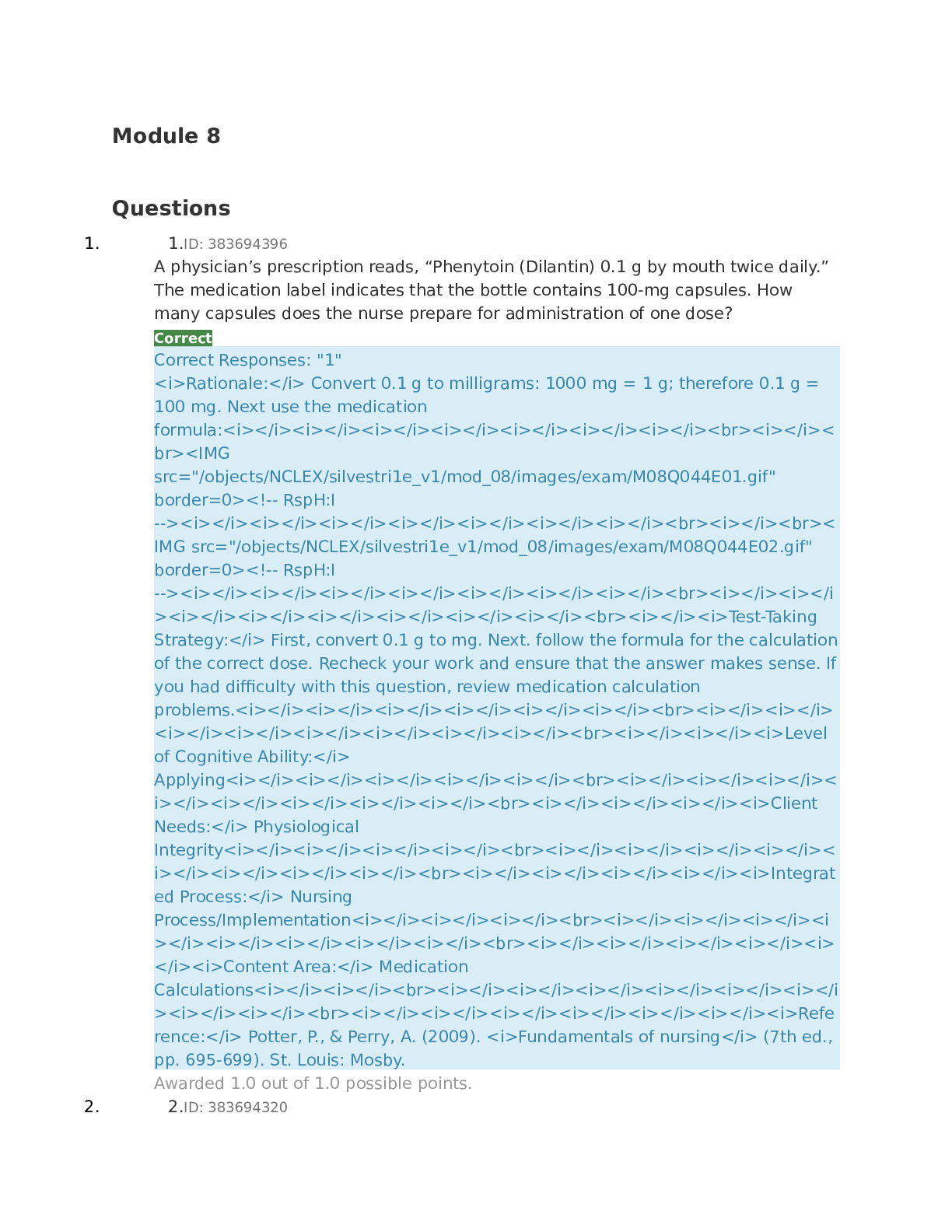
Reviews( 0 )
Document information
Connected school, study & course
About the document
Uploaded On
Aug 25, 2021
Number of pages
78
Written in
Additional information
This document has been written for:
Uploaded
Aug 25, 2021
Downloads
0
Views
46


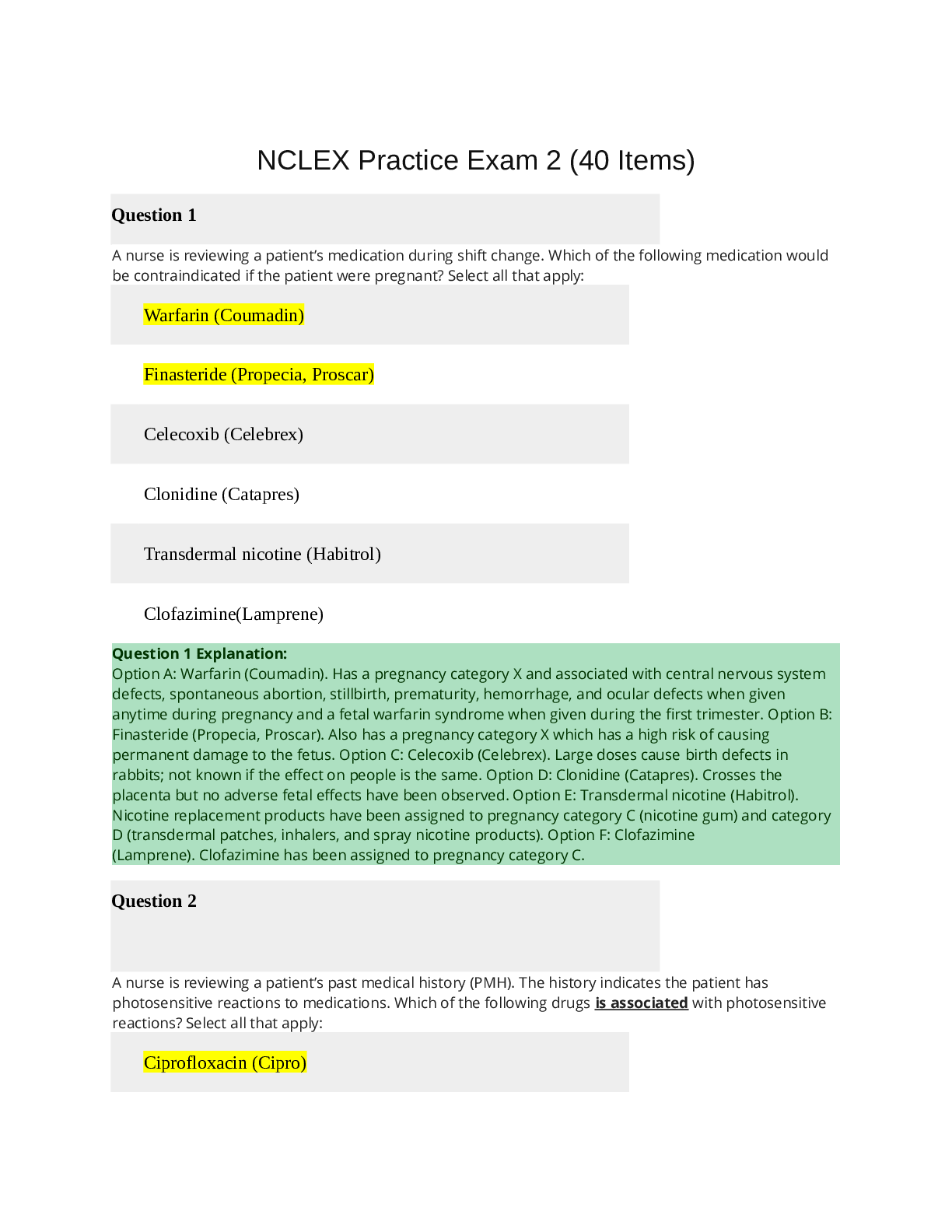
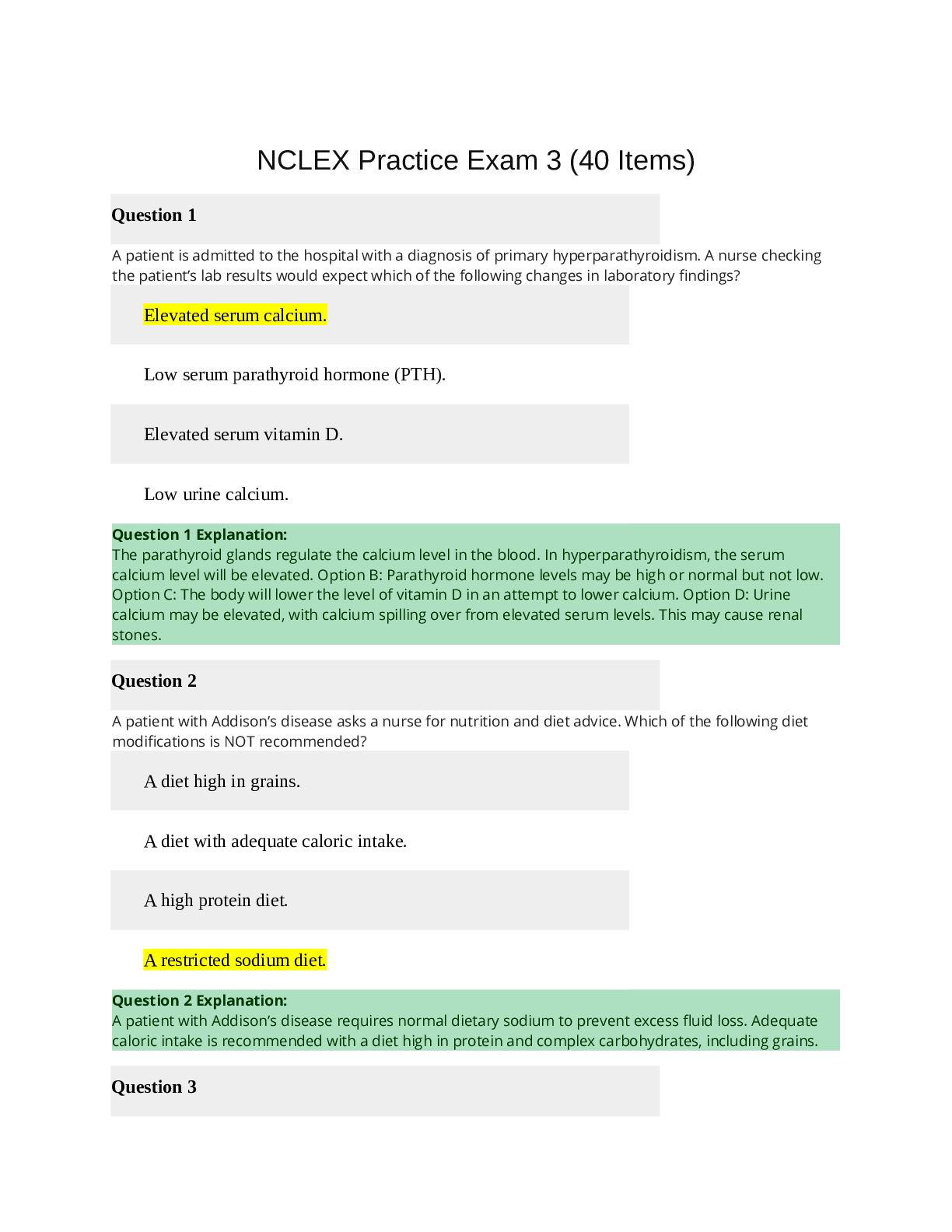
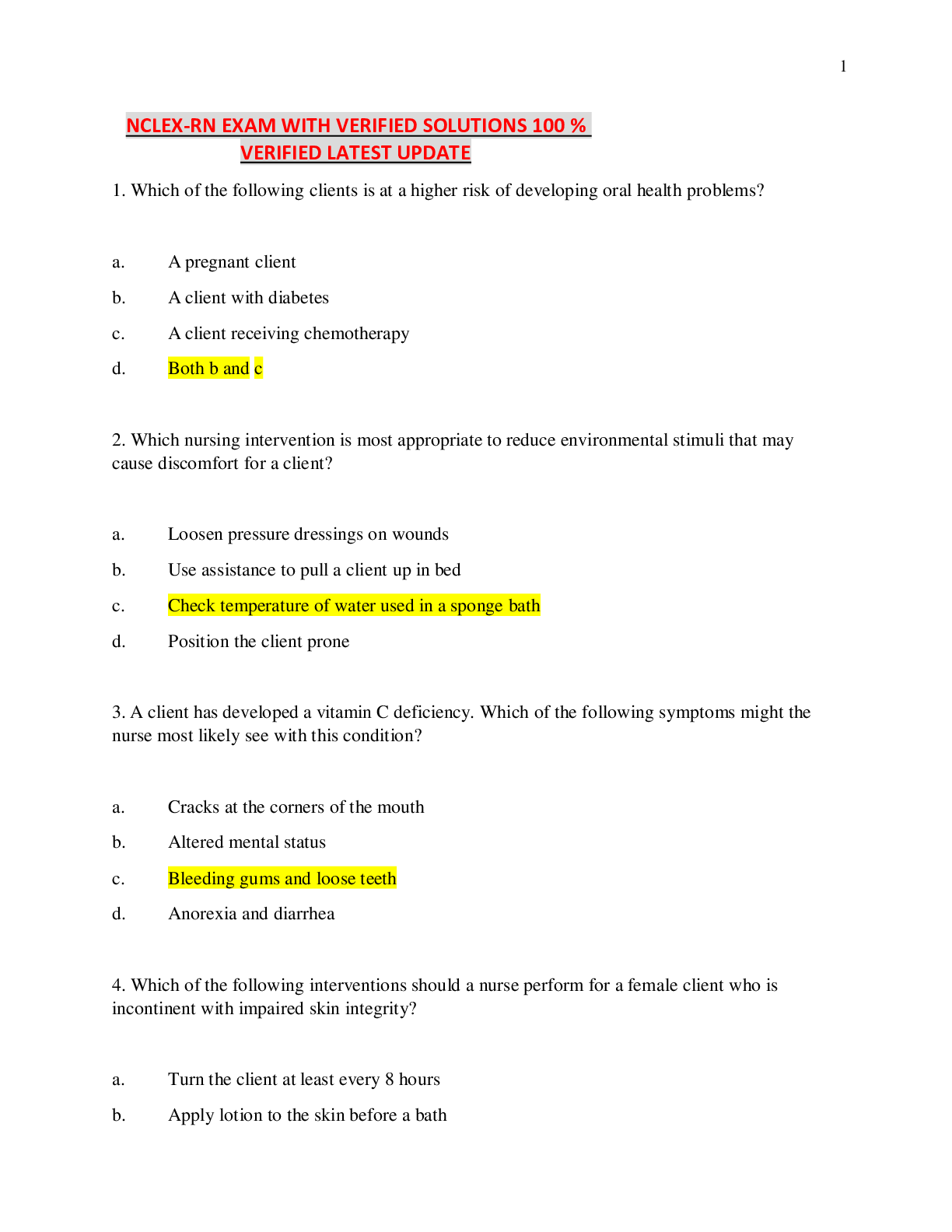
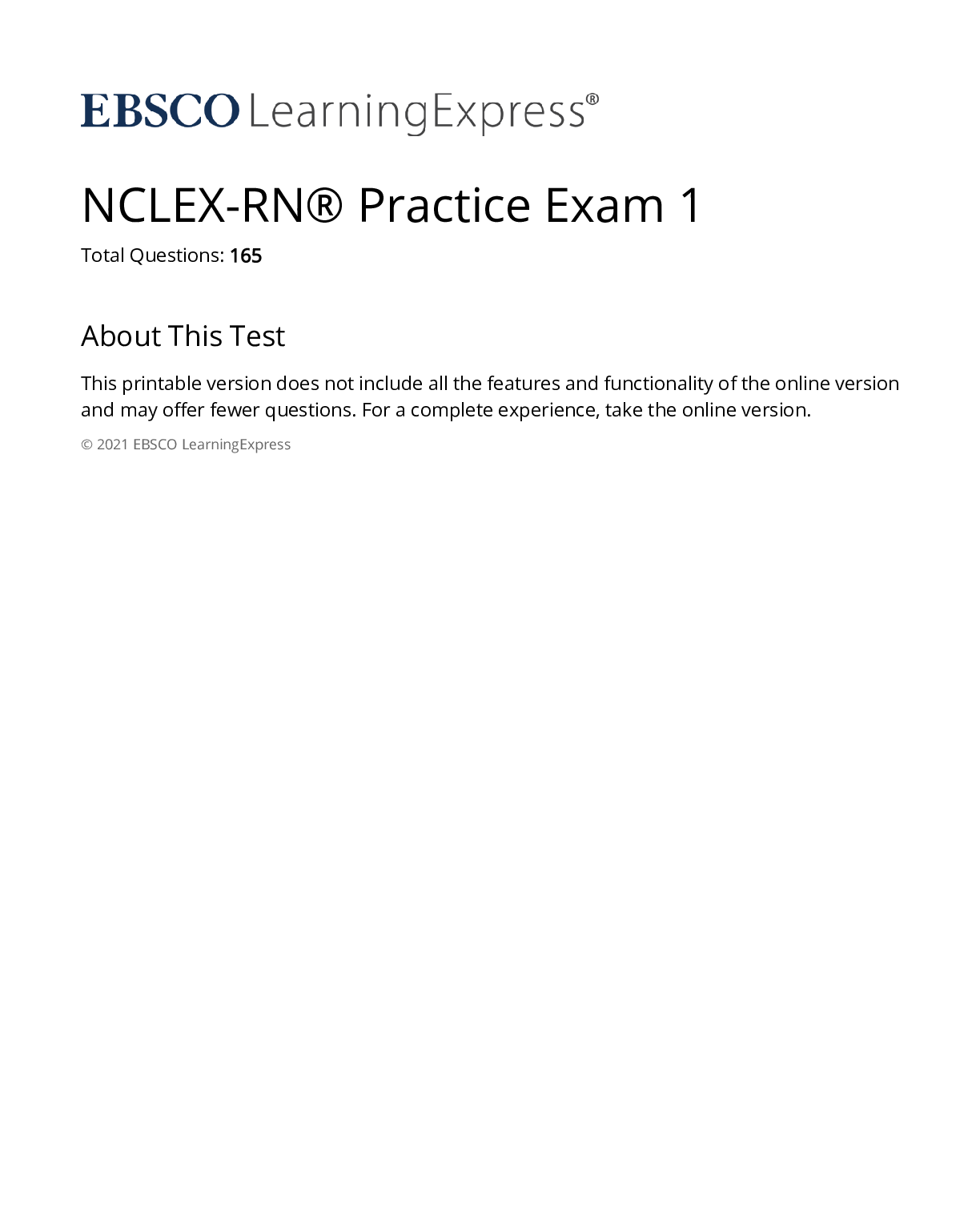

 (1).png)

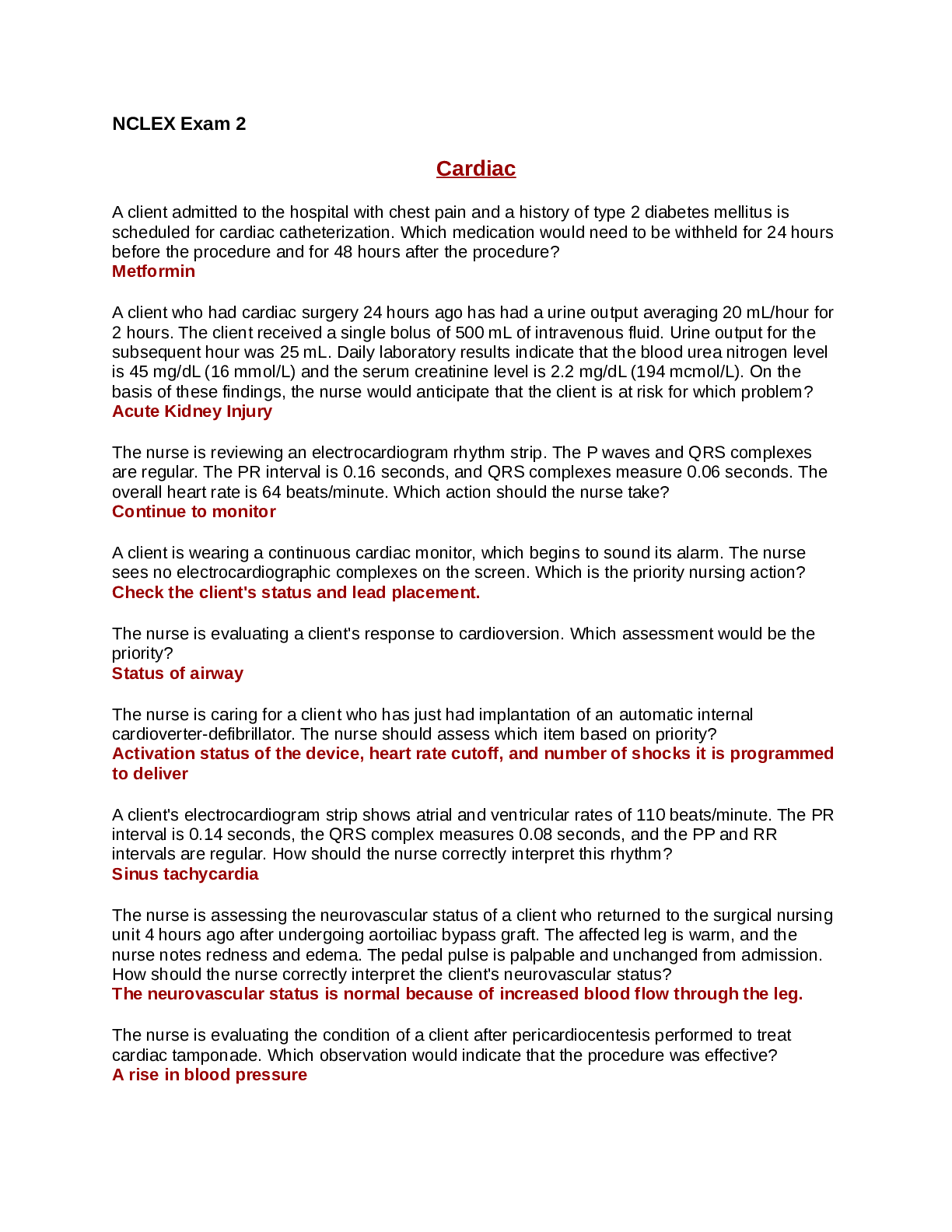
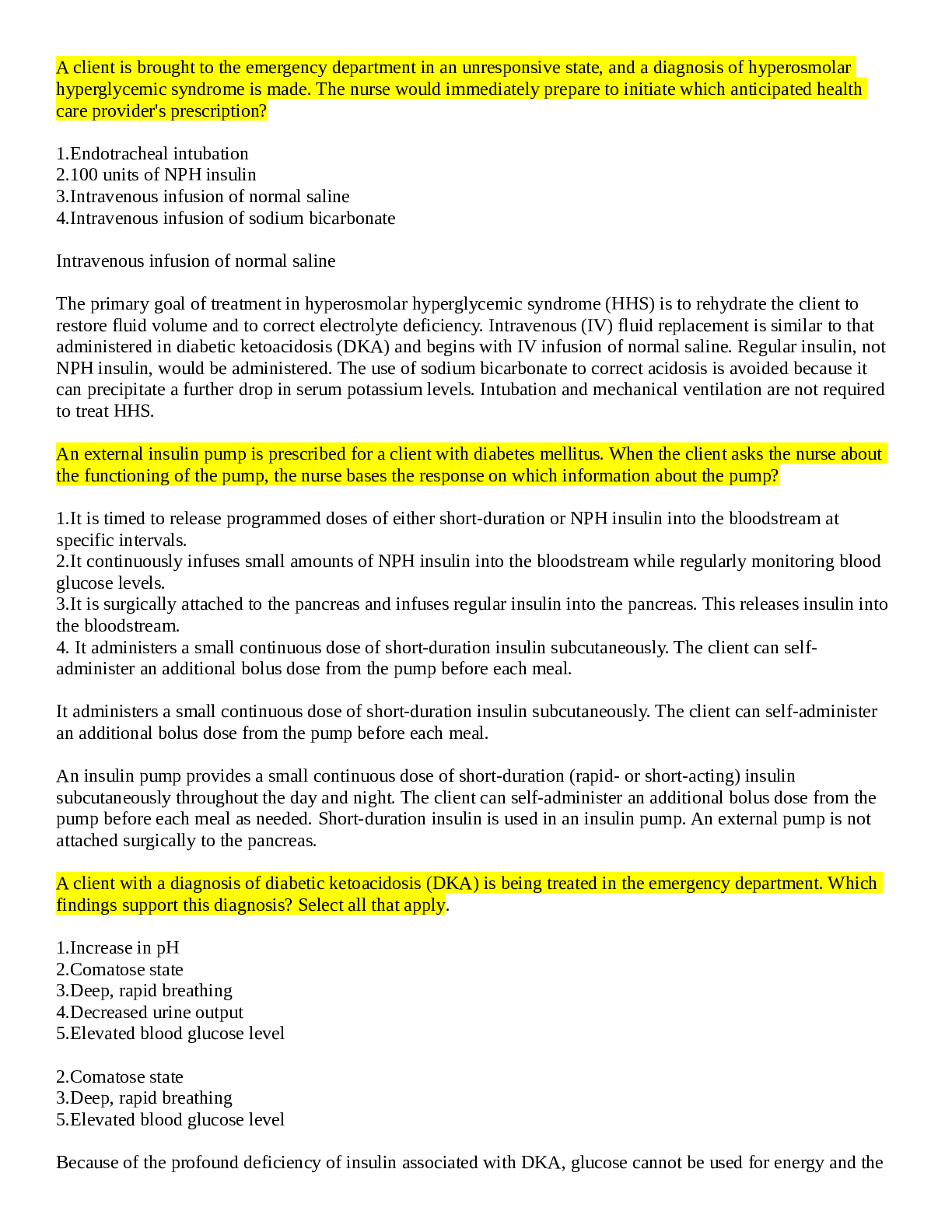
.png)
.png)

